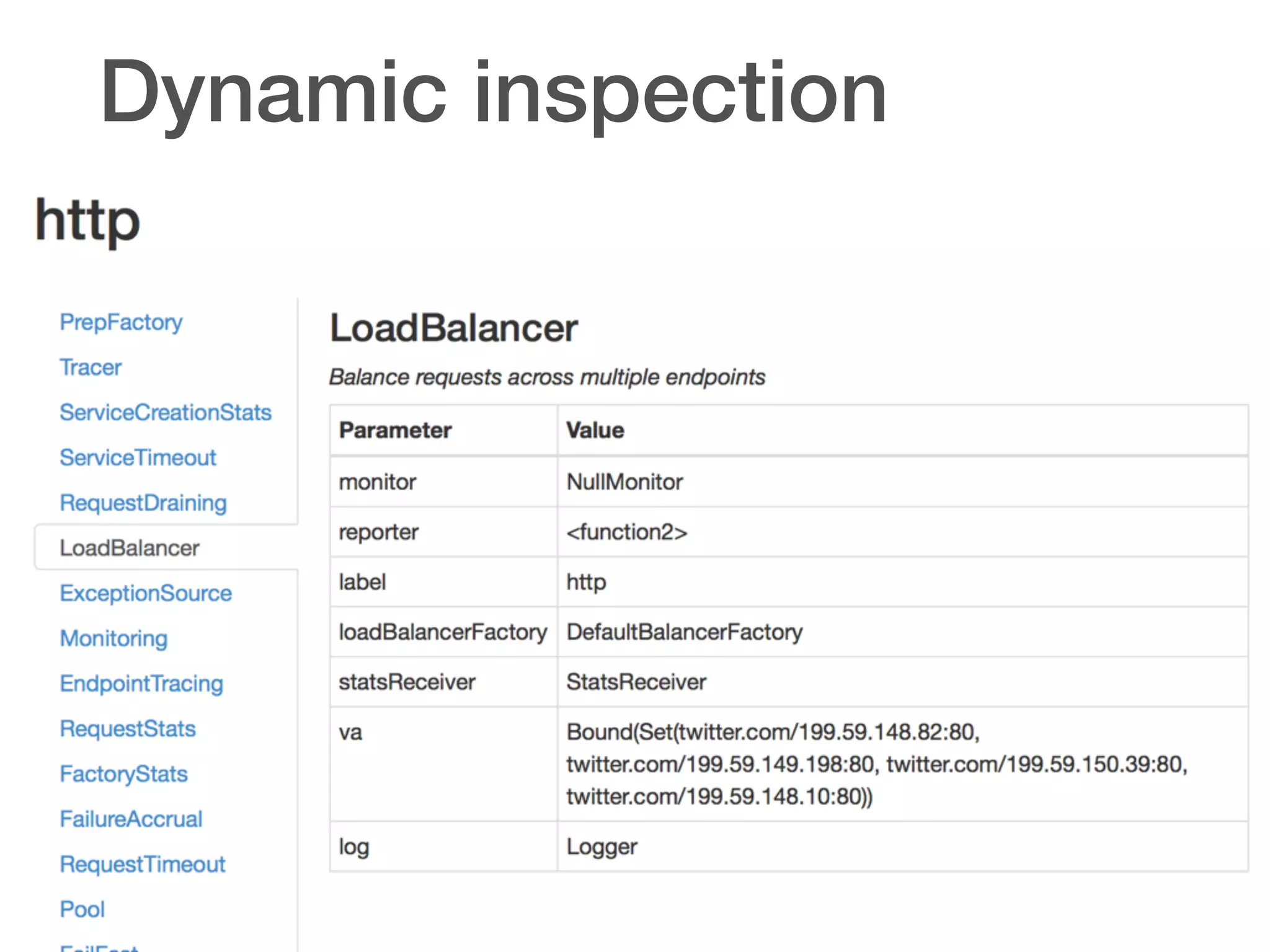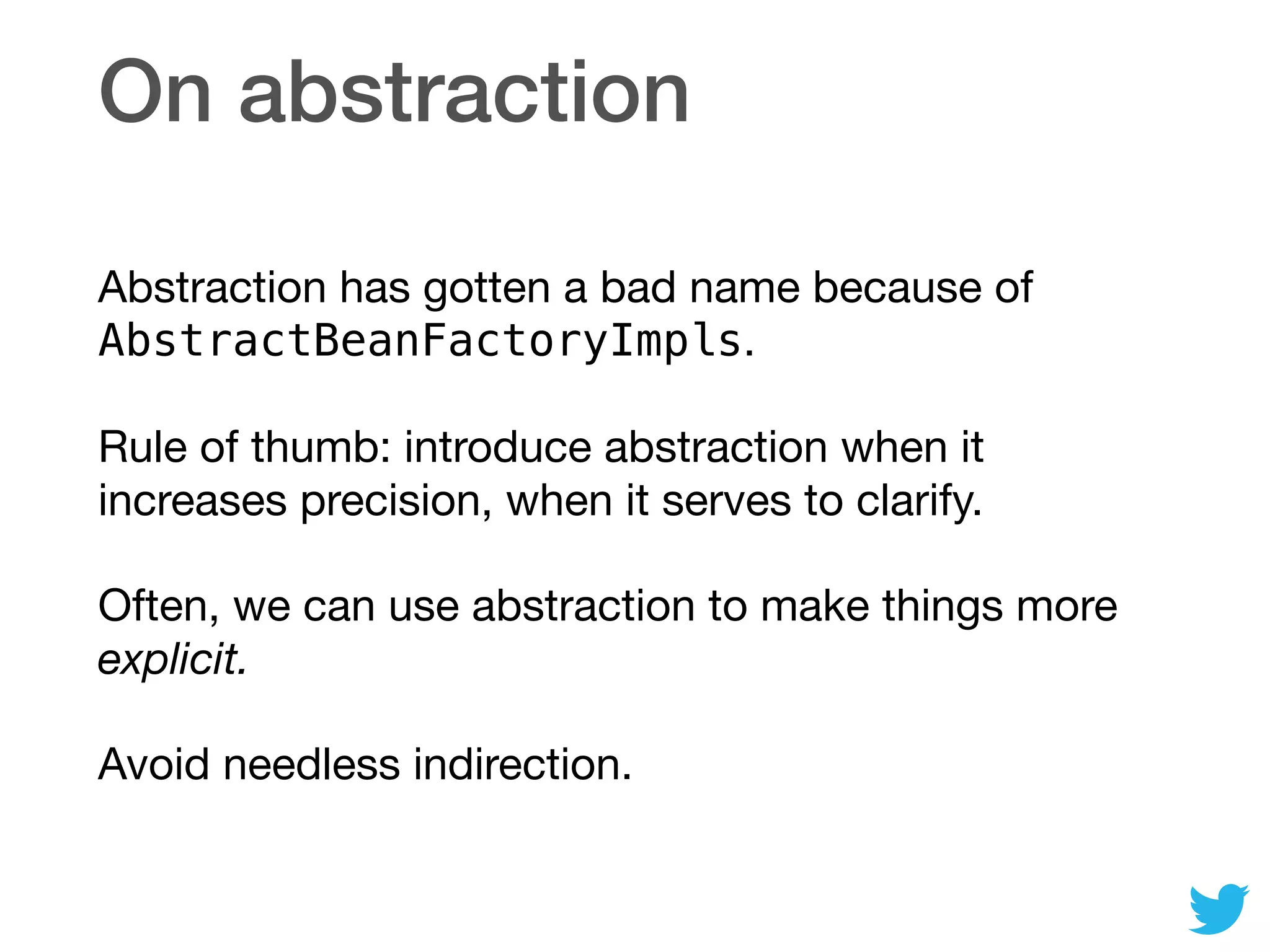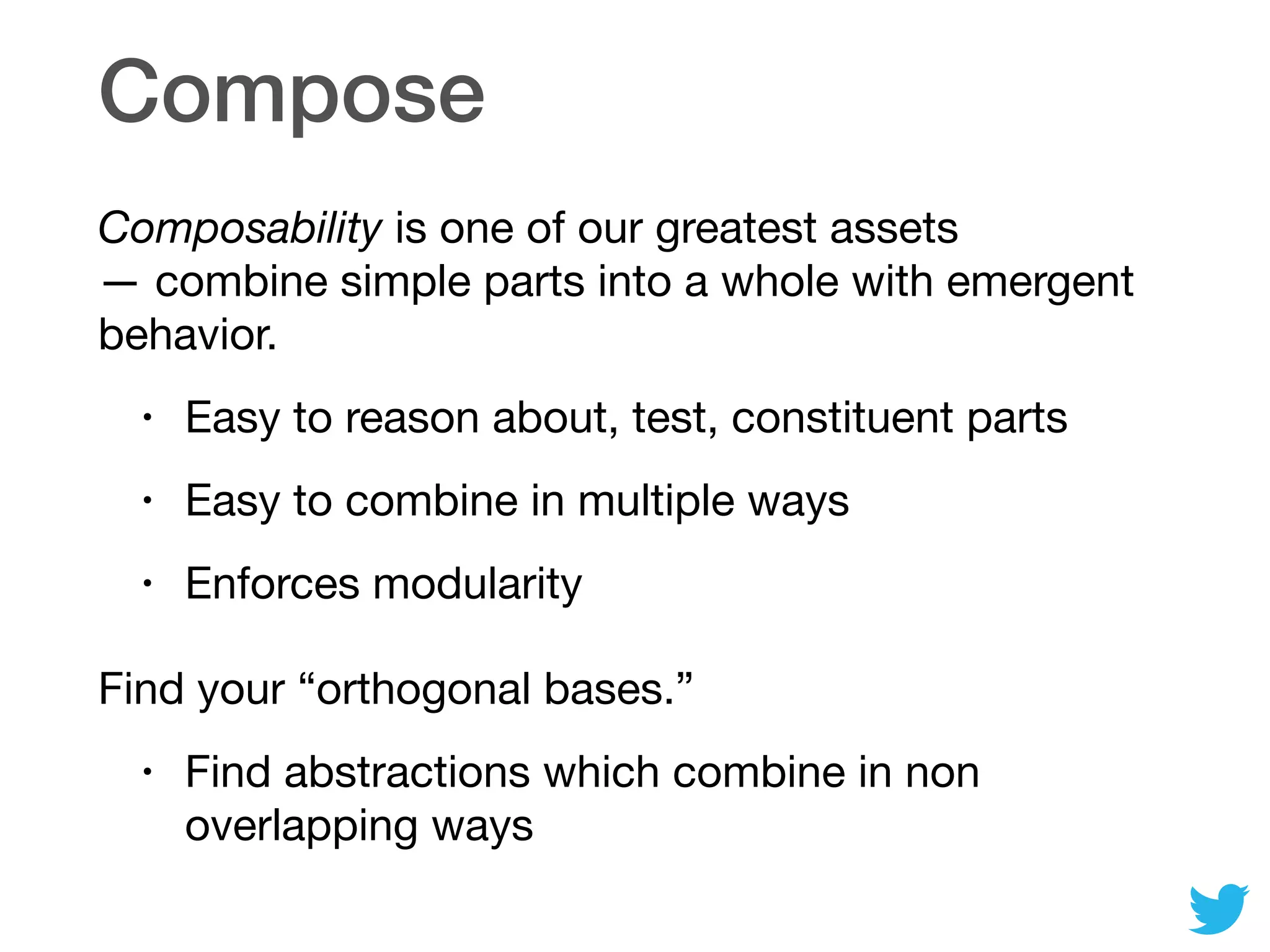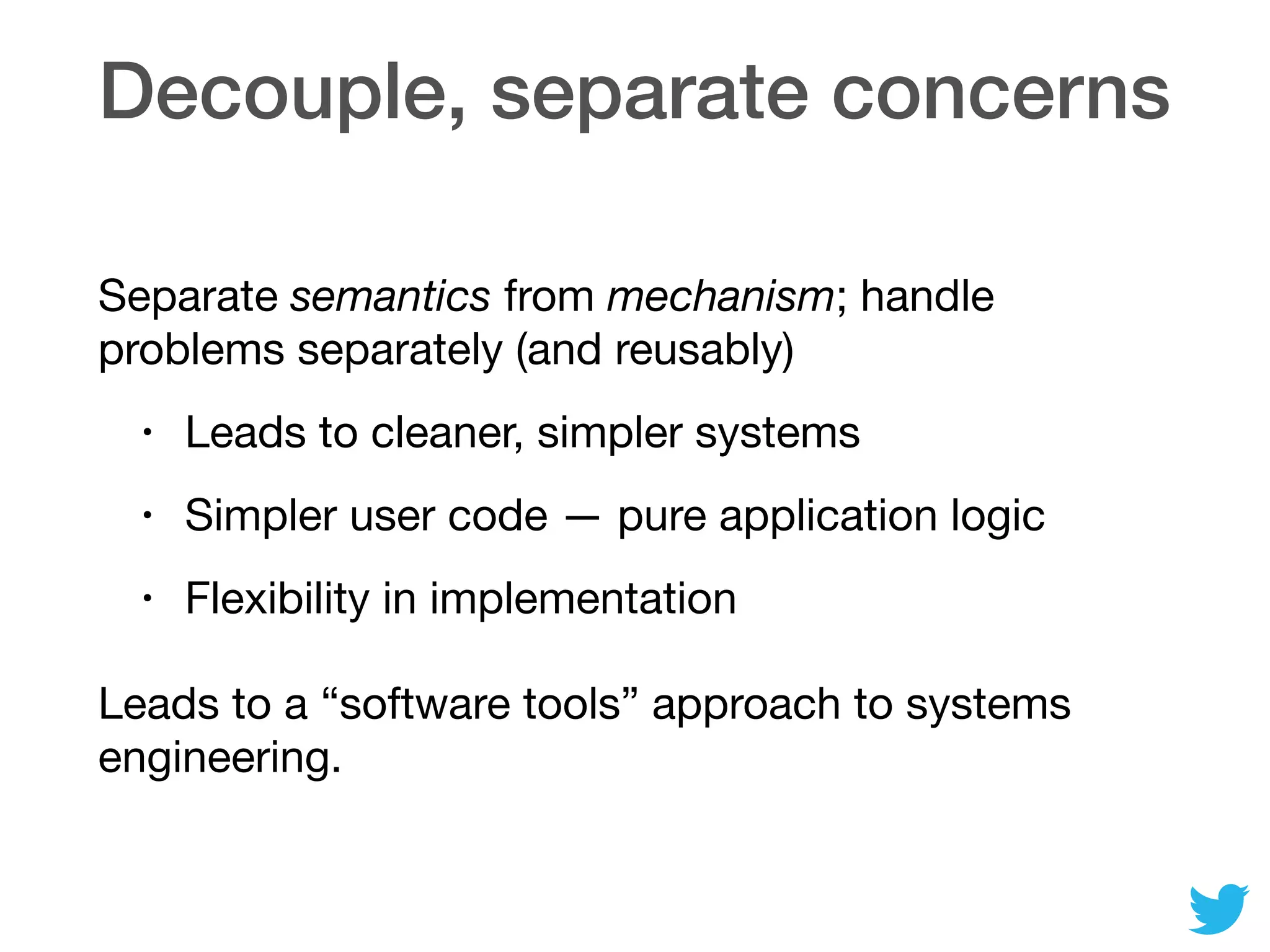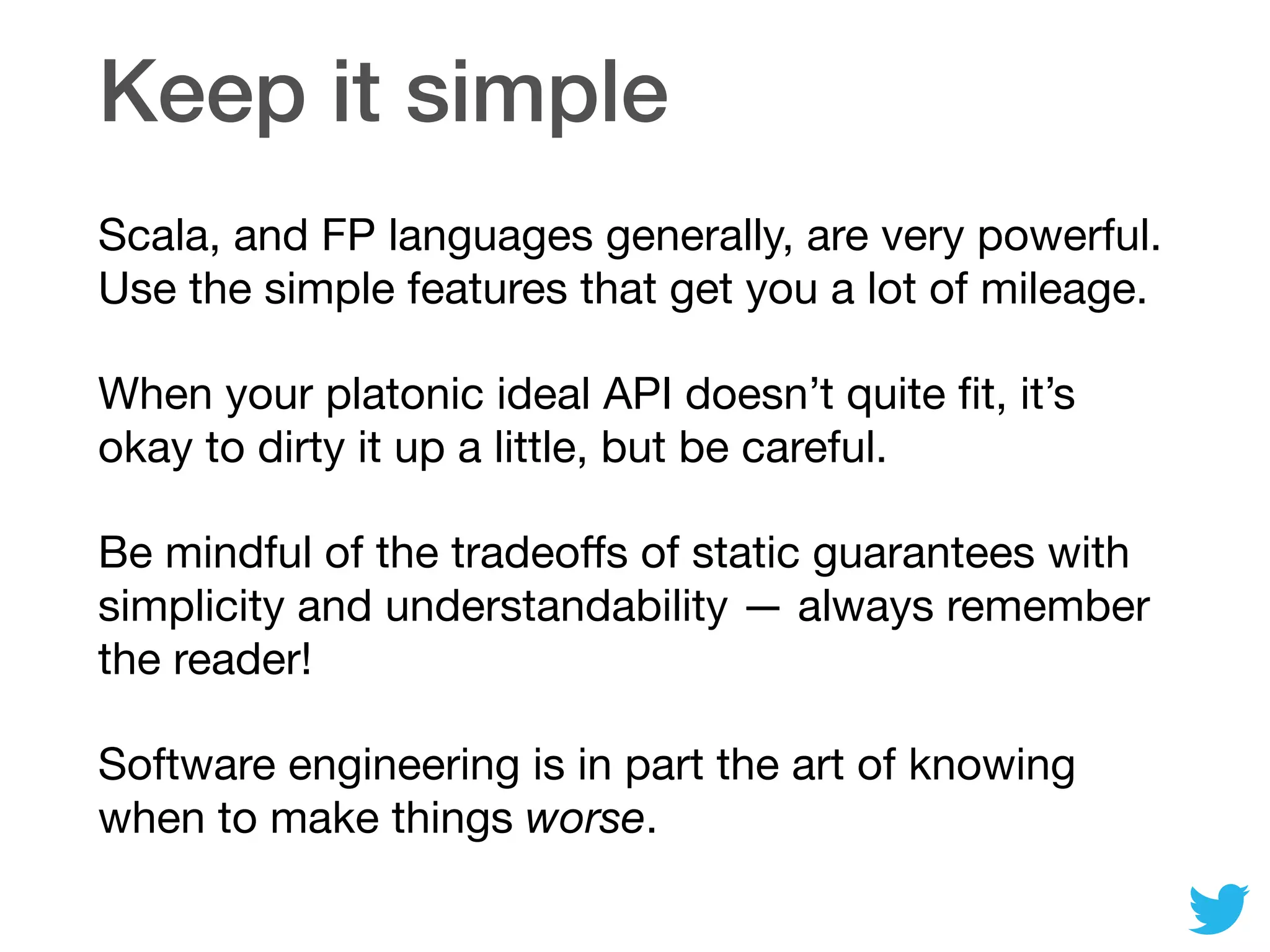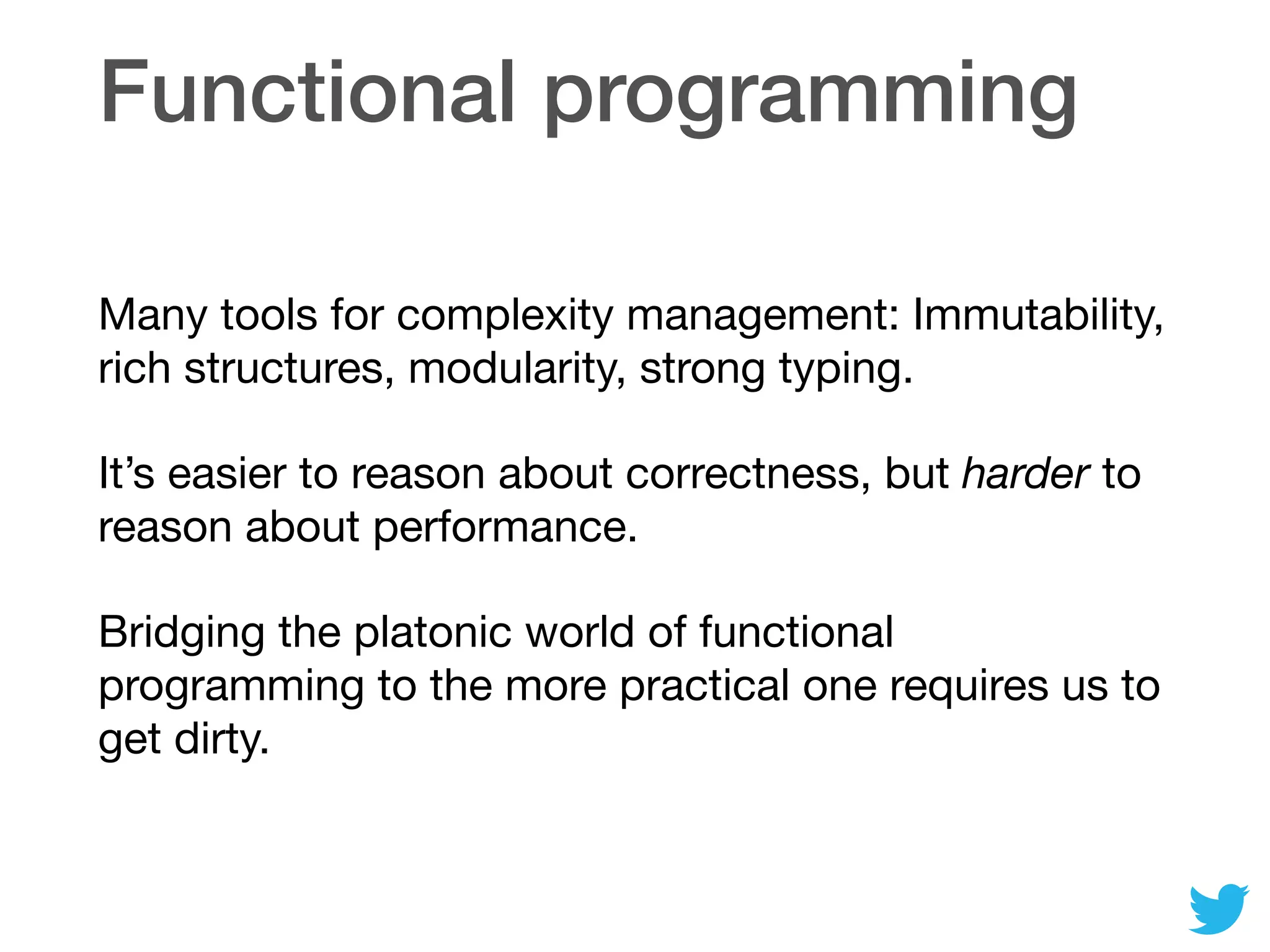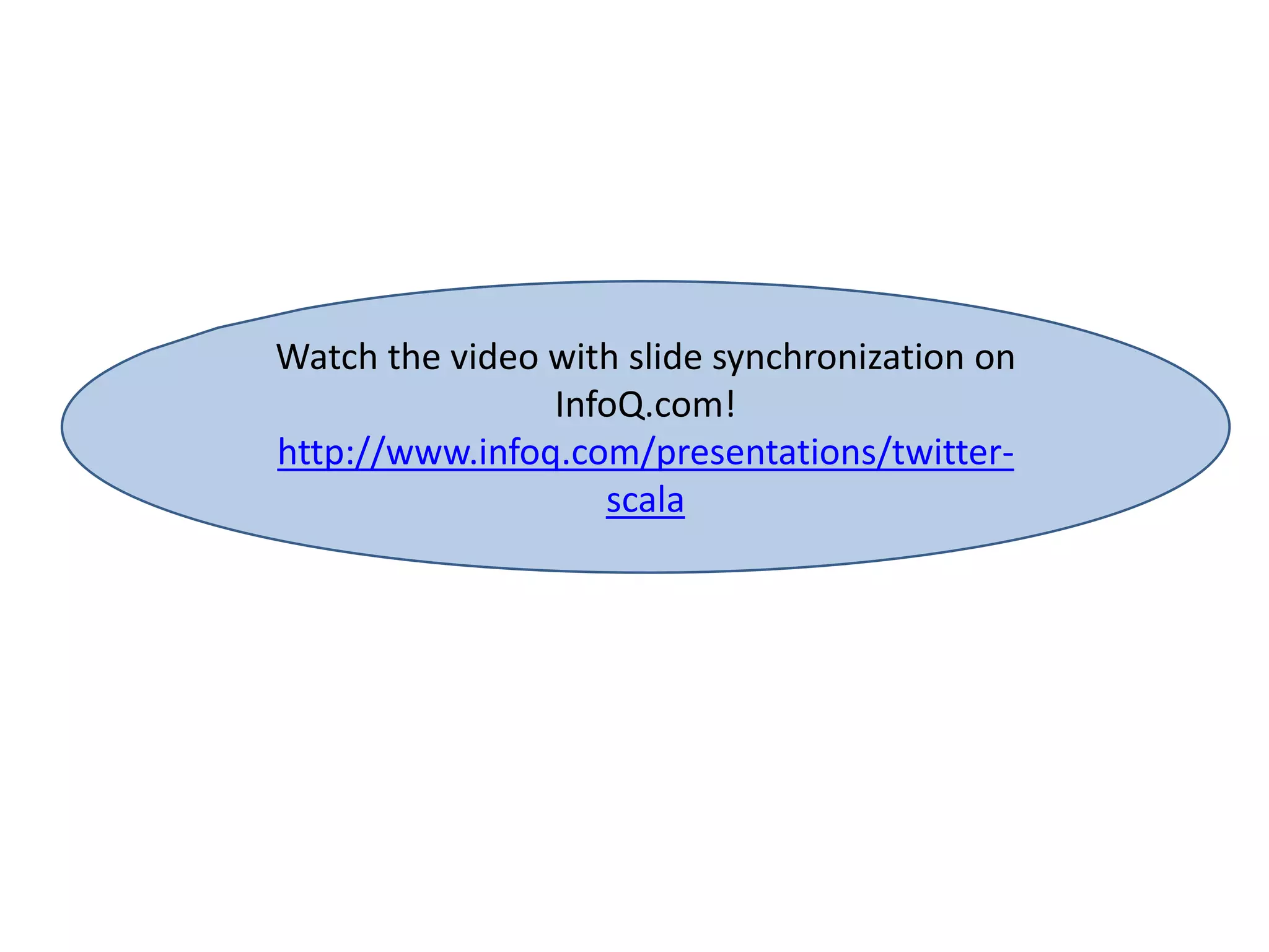The document presents the use of functional programming in system design, emphasizing its role in managing complexity and enhancing performance in large-scale internet services. It explores three key applications: representing servers as functions, state machines as formulas, and software stacks as values, highlighting the benefits of futures and event management in asynchronous programming. The document also discusses the structure and behavior of service filters that enhance modular design, allowing for effective resource management and system configuration.



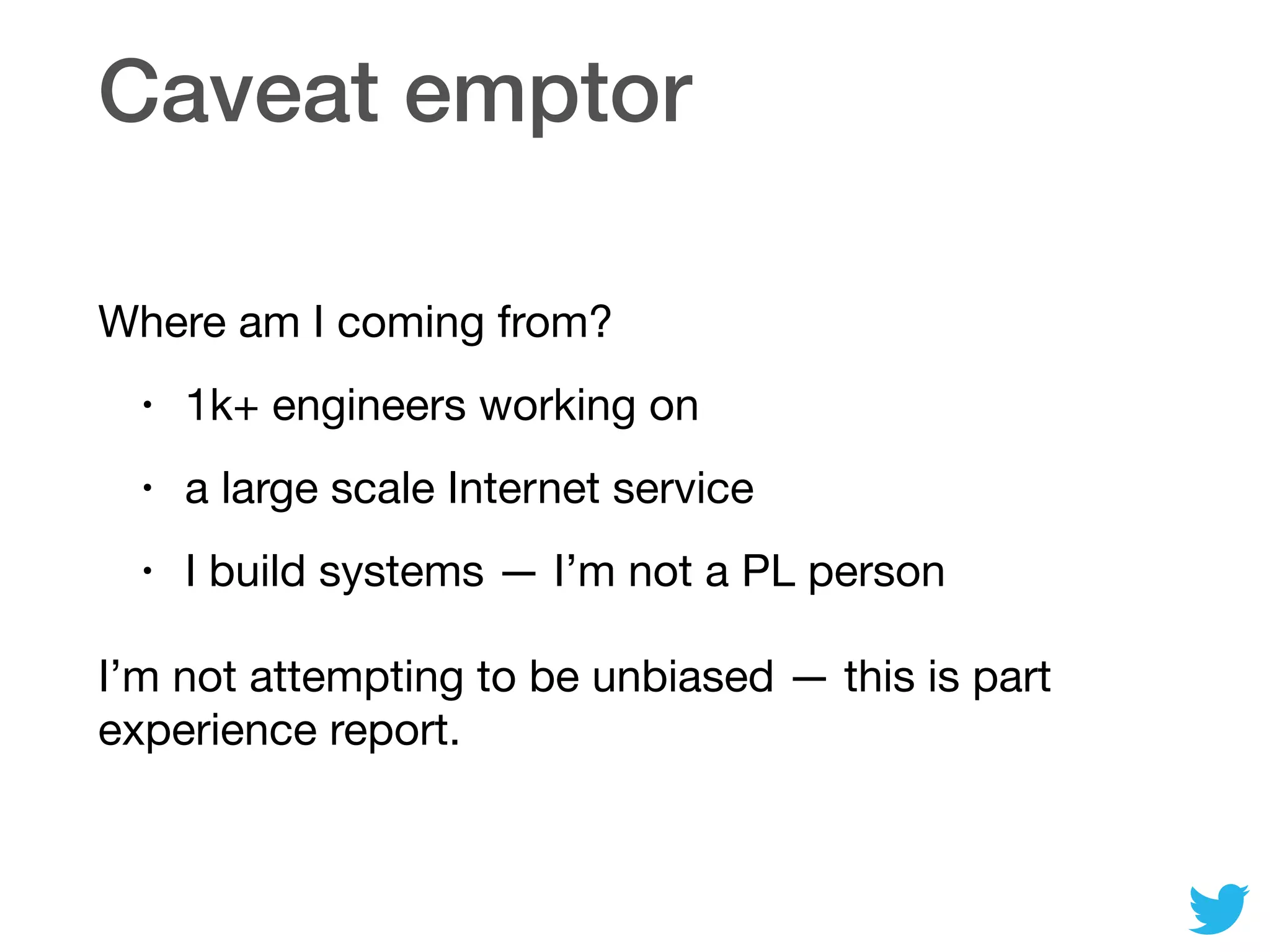
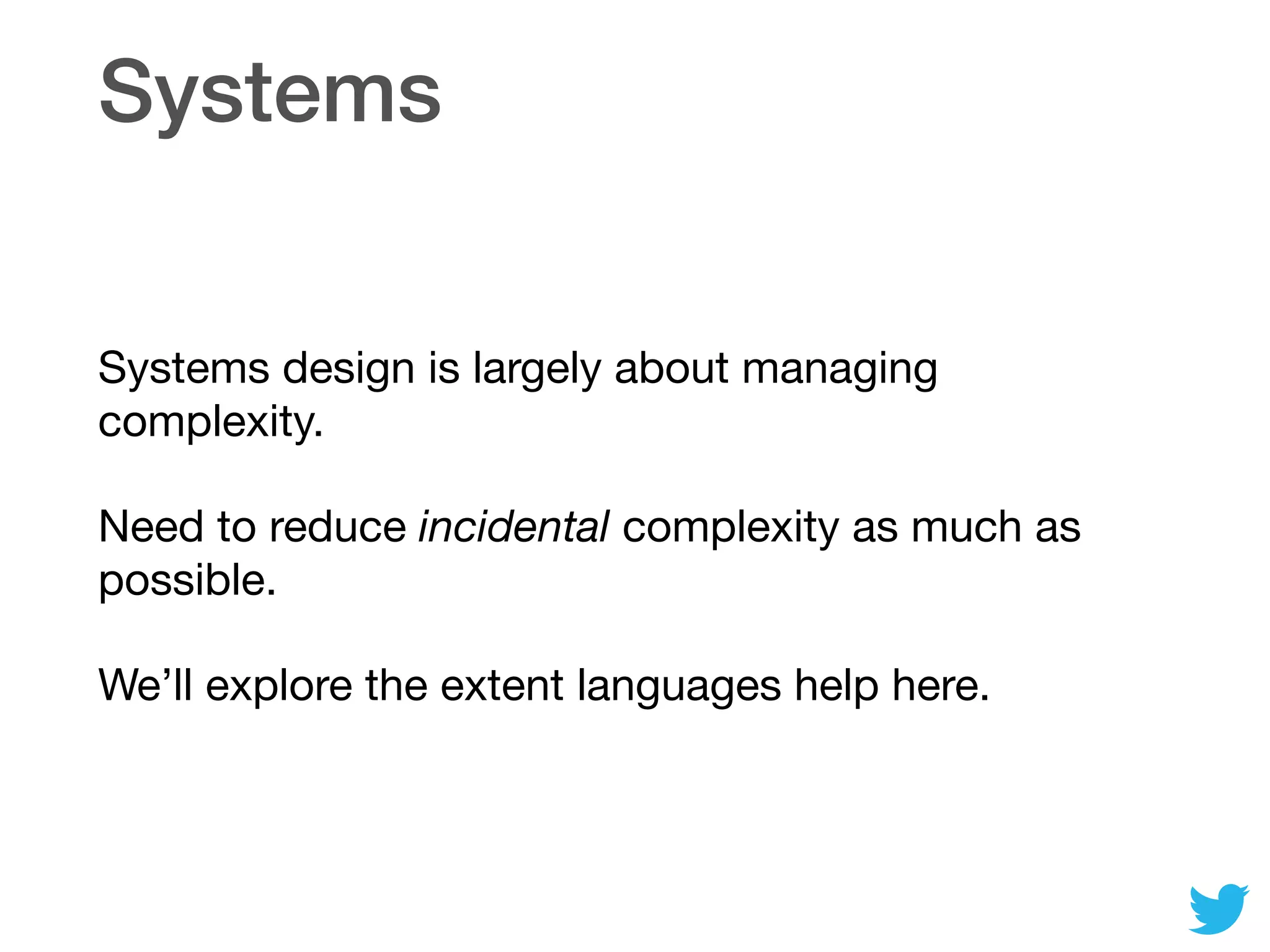
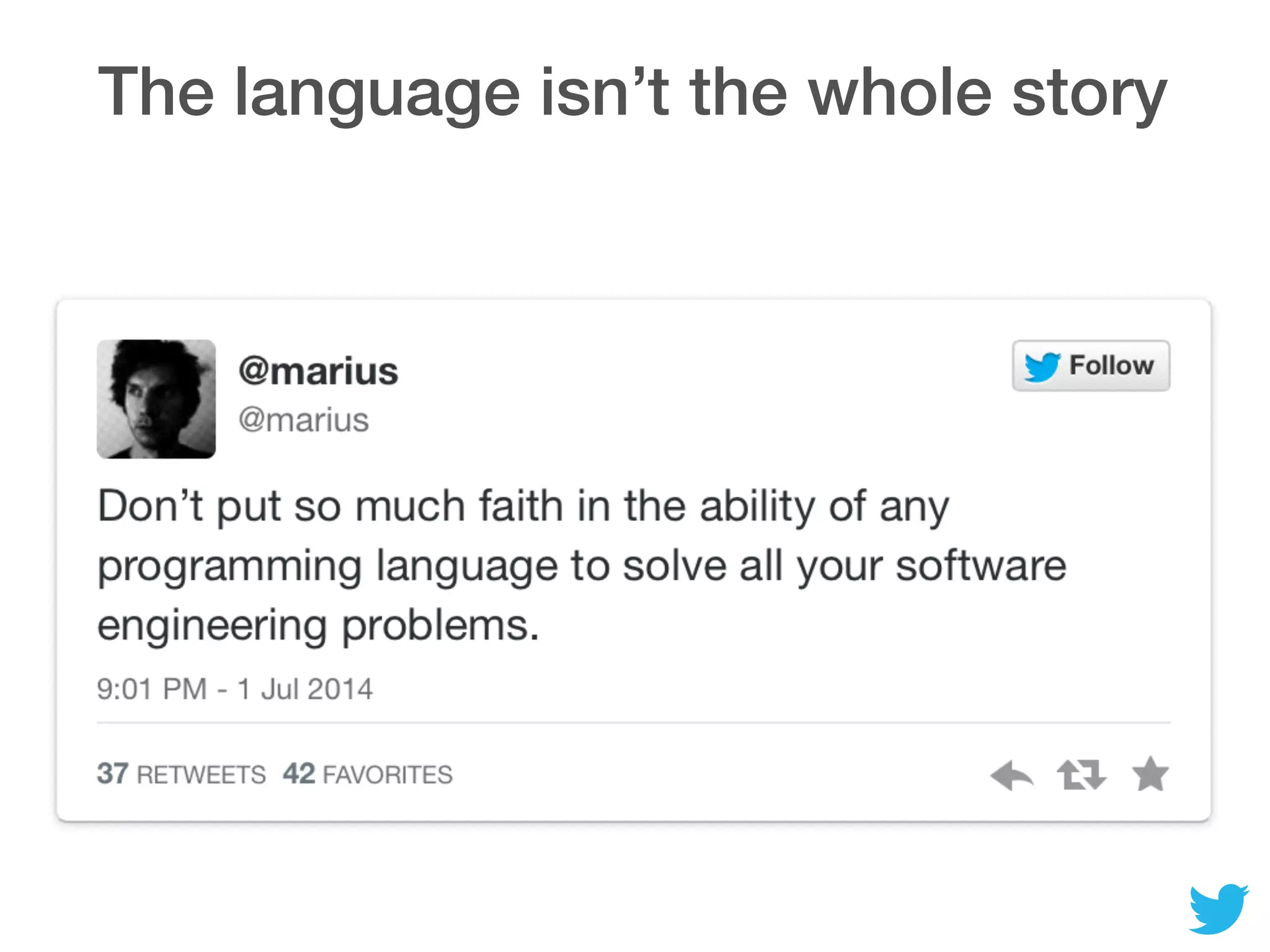
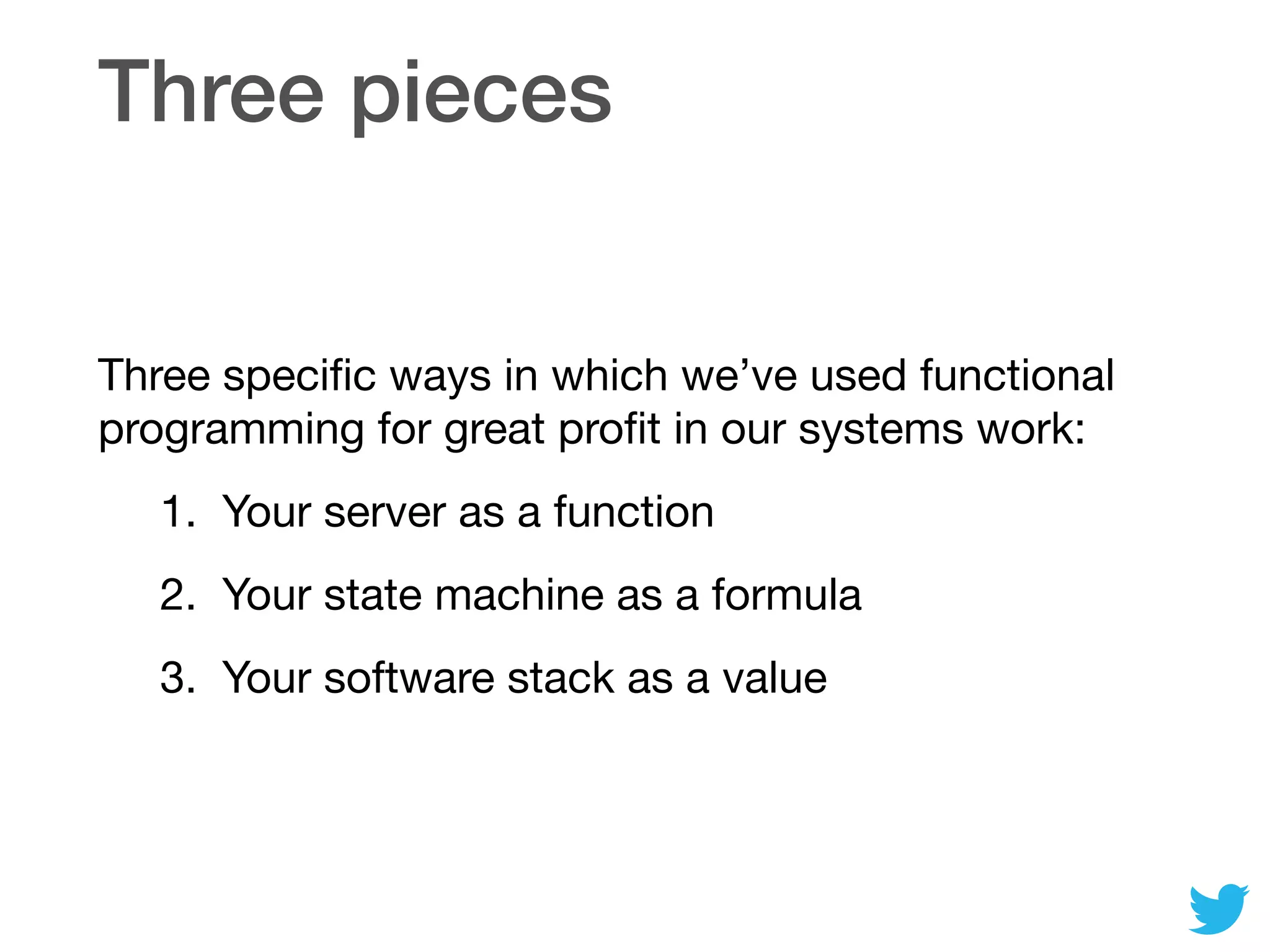
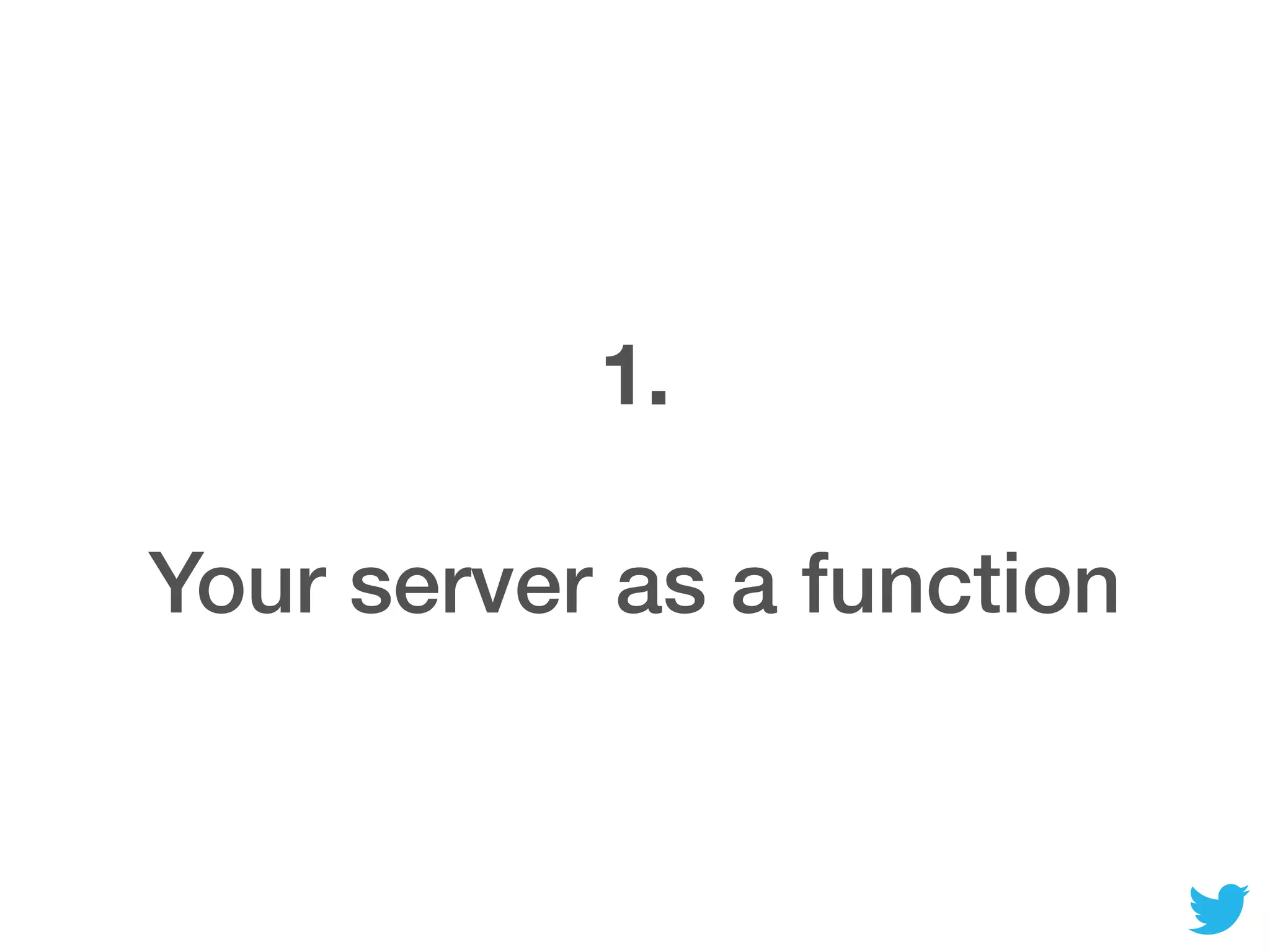
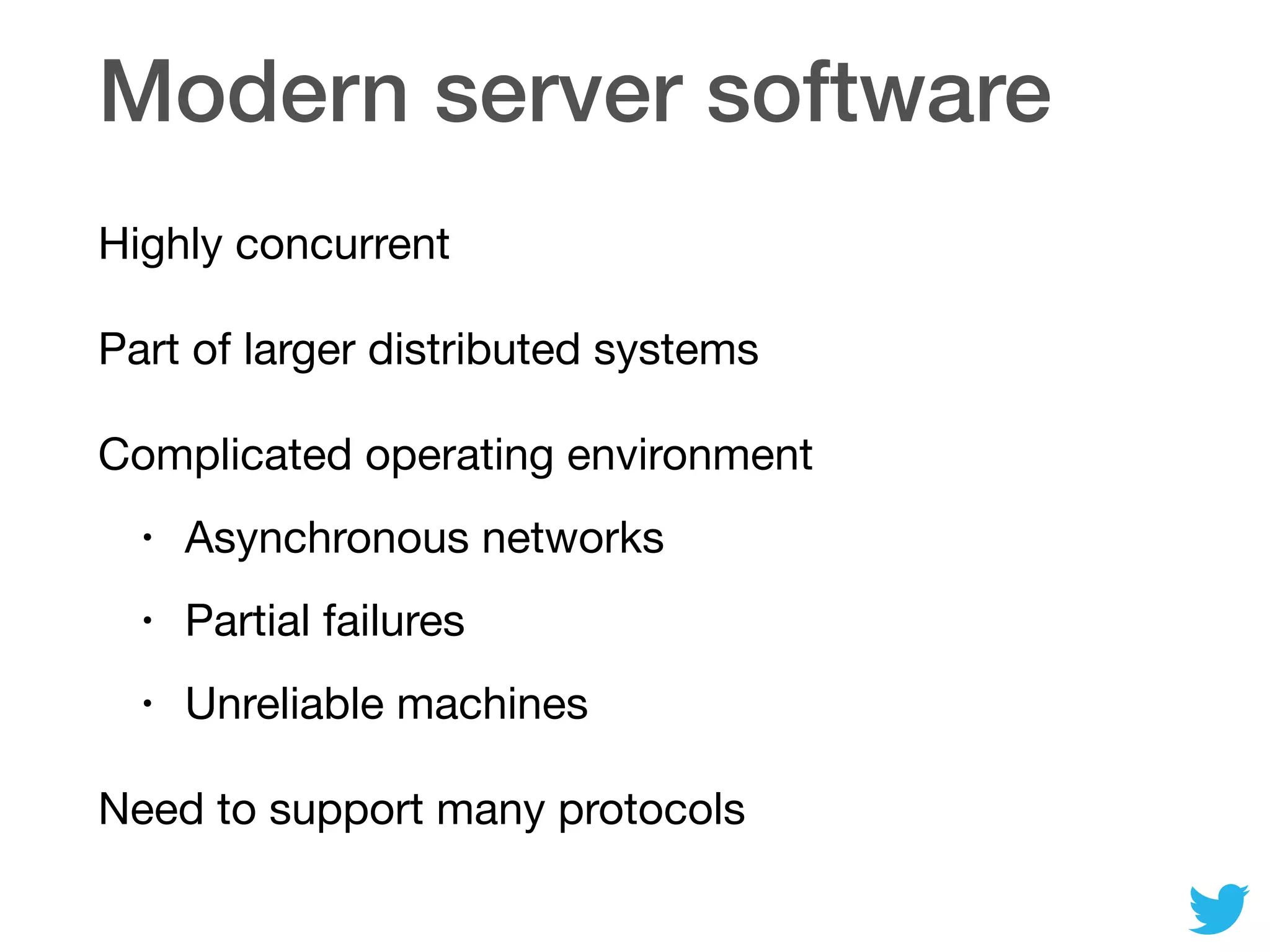
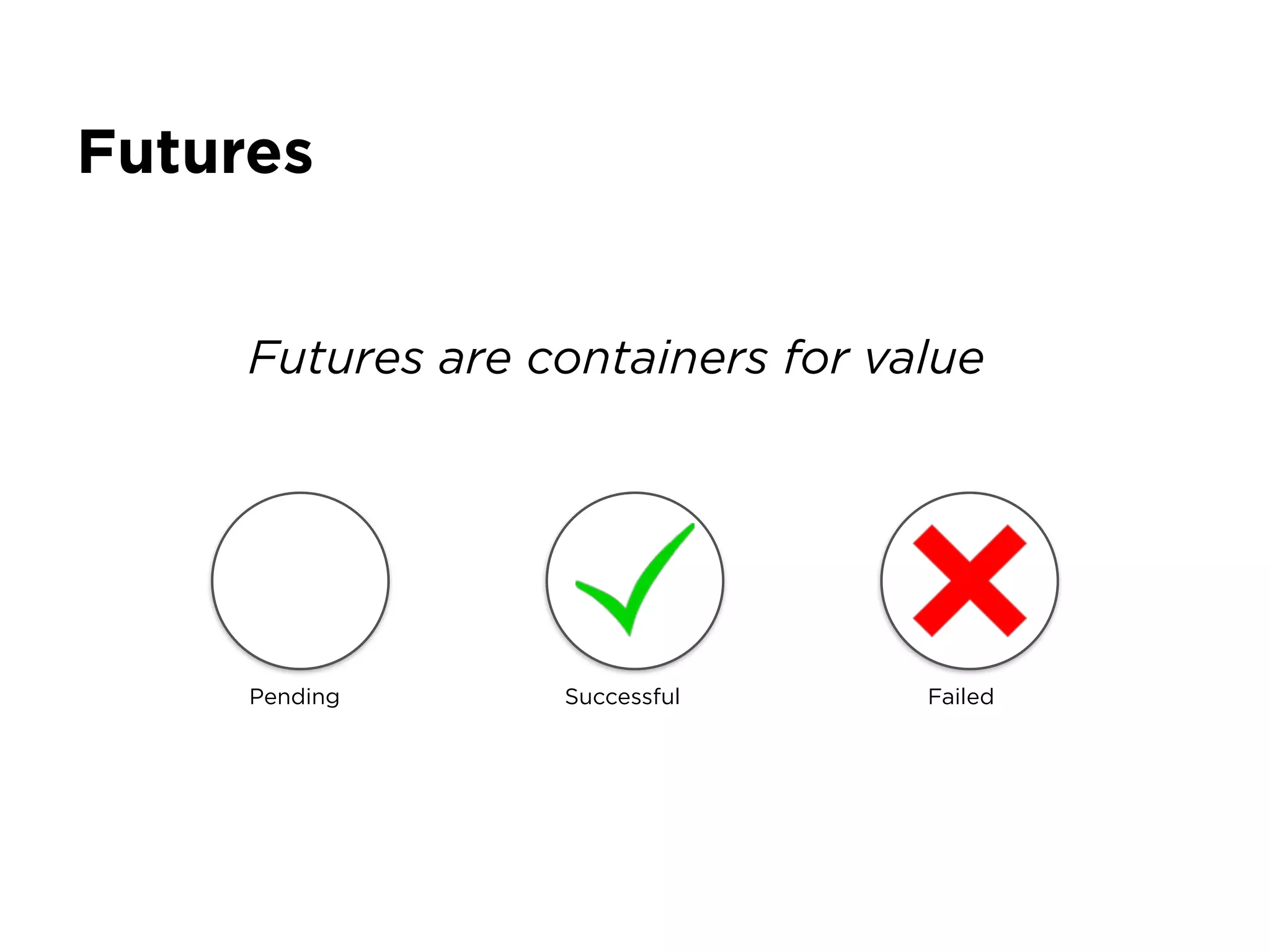
![Futures
val a: Future[Int]
a](https://image.slidesharecdn.com/untitled-150112070044-conversion-gate01/75/Functional-Systems-Twitter-11-2048.jpg)
![Futures
val a: Future[Int]
val b = a map { x => x + 512 }
a
b](https://image.slidesharecdn.com/untitled-150112070044-conversion-gate01/75/Functional-Systems-Twitter-12-2048.jpg)
![Futures
val a: Future[Int]
val b = a map { x => x + 512 }
val c = a map { x => 64 / x }
a
b
c](https://image.slidesharecdn.com/untitled-150112070044-conversion-gate01/75/Functional-Systems-Twitter-13-2048.jpg)
![Futures
val a: Future[Int]
val b = a map { x => x + 512 }
val c = a map { x => 64 / x }
val d = Future.join(b,c)
a
b
c
d](https://image.slidesharecdn.com/untitled-150112070044-conversion-gate01/75/Functional-Systems-Twitter-14-2048.jpg)
![Futures
val a: Future[Int]
val b = a map { x => x + 512 }
val c = a map { x => 64 / x }
val d = Future.join(b,c)
val e = d map { case (x, y) => x + y }
a
b
c
d e](https://image.slidesharecdn.com/untitled-150112070044-conversion-gate01/75/Functional-Systems-Twitter-15-2048.jpg)
![Futures
val a: Future[Int]
val b = a map { x => x + 512 }
val c = a map { x => 64 / x }
val d = Future.join(b,c)
val e = d map { case (x, y) => x + y }
a
16 b
c
d e](https://image.slidesharecdn.com/untitled-150112070044-conversion-gate01/75/Functional-Systems-Twitter-16-2048.jpg)
![Futures
val a: Future[Int]
val b = a map { x => x + 512 }
val c = a map { x => 64 / x }
val d = Future.join(b,c)
val e = d map { case (x, y) => x + y }
a
16 b
c
d e](https://image.slidesharecdn.com/untitled-150112070044-conversion-gate01/75/Functional-Systems-Twitter-17-2048.jpg)
![Futures
val a: Future[Int]
val b = a map { x => x + 512 }
val c = a map { x => 64 / x }
val d = Future.join(b,c)
val e = d map { case (x, y) => x + y }
a
16
528
b
c
d e](https://image.slidesharecdn.com/untitled-150112070044-conversion-gate01/75/Functional-Systems-Twitter-18-2048.jpg)
![Futures
val a: Future[Int]
val b = a map { x => x + 512 }
val c = a map { x => 64 / x }
val d = Future.join(b,c)
val e = d map { case (x, y) => x + y }
a
16
528
b
c
d e](https://image.slidesharecdn.com/untitled-150112070044-conversion-gate01/75/Functional-Systems-Twitter-19-2048.jpg)
![Futures
val a: Future[Int]
val b = a map { x => x + 512 }
val c = a map { x => 64 / x }
val d = Future.join(b,c)
val e = d map { case (x, y) => x + y }
a
16
528
4
b
c
d e](https://image.slidesharecdn.com/untitled-150112070044-conversion-gate01/75/Functional-Systems-Twitter-20-2048.jpg)
![Futures
val a: Future[Int]
val b = a map { x => x + 512 }
val c = a map { x => 64 / x }
val d = Future.join(b,c)
val e = d map { case (x, y) => x + y }
a
16
528
4
b
c
d e](https://image.slidesharecdn.com/untitled-150112070044-conversion-gate01/75/Functional-Systems-Twitter-21-2048.jpg)
![Futures
val a: Future[Int]
val b = a map { x => x + 512 }
val c = a map { x => 64 / x }
val d = Future.join(b,c)
val e = d map { case (x, y) => x + y }
a
16
528
4
b
c
d e](https://image.slidesharecdn.com/untitled-150112070044-conversion-gate01/75/Functional-Systems-Twitter-22-2048.jpg)
![Futures
val a: Future[Int]
val b = a map { x => x + 512 }
val c = a map { x => 64 / x }
val d = Future.join(b,c)
val e = d map { case (x, y) => x + y }
a
16
528
4
(528,
4)
b
c
d e](https://image.slidesharecdn.com/untitled-150112070044-conversion-gate01/75/Functional-Systems-Twitter-23-2048.jpg)
![Futures
val a: Future[Int]
val b = a map { x => x + 512 }
val c = a map { x => 64 / x }
val d = Future.join(b,c)
val e = d map { case (x, y) => x + y }
a
16
528
4
(528,
4)
b
c
d e](https://image.slidesharecdn.com/untitled-150112070044-conversion-gate01/75/Functional-Systems-Twitter-24-2048.jpg)
![Futures
val a: Future[Int]
val b = a map { x => x + 512 }
val c = a map { x => 64 / x }
val d = Future.join(b,c)
val e = d map { case (x, y) => x + y }
a
16
528
4
(528,
4)
532b
c
d e](https://image.slidesharecdn.com/untitled-150112070044-conversion-gate01/75/Functional-Systems-Twitter-25-2048.jpg)
![Futures
val a: Future[Int]
val b = a map { x => x + 512 }
val c = a map { x => 64 / x }
val d = Future.join(b,c)
val e = d map { case (x, y) => x + y }
a
0 b
c
d e](https://image.slidesharecdn.com/untitled-150112070044-conversion-gate01/75/Functional-Systems-Twitter-26-2048.jpg)
![Futures
val a: Future[Int]
val b = a map { x => x + 512 }
val c = a map { x => 64 / x }
val d = Future.join(b,c)
val e = d map { case (x, y) => x + y }
a
0
512
b
c
d e](https://image.slidesharecdn.com/untitled-150112070044-conversion-gate01/75/Functional-Systems-Twitter-27-2048.jpg)
![Futures
val a: Future[Int]
val b = a map { x => x + 512 }
val c = a map { x => 64 / x }
val d = Future.join(b,c)
val e = d map { case (x, y) => x + y }
a
0
512
Ex
b
c
d e](https://image.slidesharecdn.com/untitled-150112070044-conversion-gate01/75/Functional-Systems-Twitter-28-2048.jpg)
![Futures
val a: Future[Int]
val b = a map { x => x + 512 }
val c = a map { x => 64 / x }
val d = Future.join(b,c)
val e = d map { case (x, y) => x + y }
a
0
512
Ex
Exb
c
d e](https://image.slidesharecdn.com/untitled-150112070044-conversion-gate01/75/Functional-Systems-Twitter-29-2048.jpg)
![Futures
val a: Future[Int]
val b = a map { x => x + 512 }
val c = a map { x => 64 / x }
val d = Future.join(b,c)
val e = d map { case (x, y) => x + y }
a
0
512
Ex
Ex Exb
c
d e](https://image.slidesharecdn.com/untitled-150112070044-conversion-gate01/75/Functional-Systems-Twitter-30-2048.jpg)
![Dependent composition
Futures may also be defined as a function of other
futures. We call this dependent composition.
Future[T].flatMap[U](
f: T => Future[U]): Future[U]
Given a Future[T], produce a new Future[U].
The returned Future[U] behaves as f applied to t.
The returned Future[U] fails if the outer
Future[T] fails.](https://image.slidesharecdn.com/untitled-150112070044-conversion-gate01/75/Functional-Systems-Twitter-31-2048.jpg)
![Flatmap
def auth(id: Int, pw: String): Future[User]
def get(u: User): Future[UserData]
def getAndAuth(id: Int, pw: String)
: Future[UserData]
= auth(id, pw) flatMap { u => get(u) }](https://image.slidesharecdn.com/untitled-150112070044-conversion-gate01/75/Functional-Systems-Twitter-32-2048.jpg)
![Composing errors
Futures recover from errors by another form of
dependent composition.
Future[T].rescue(
PartialFunction[Throwable,Future[T]])
Like flatMap, but operates over exceptional futures.](https://image.slidesharecdn.com/untitled-150112070044-conversion-gate01/75/Functional-Systems-Twitter-33-2048.jpg)
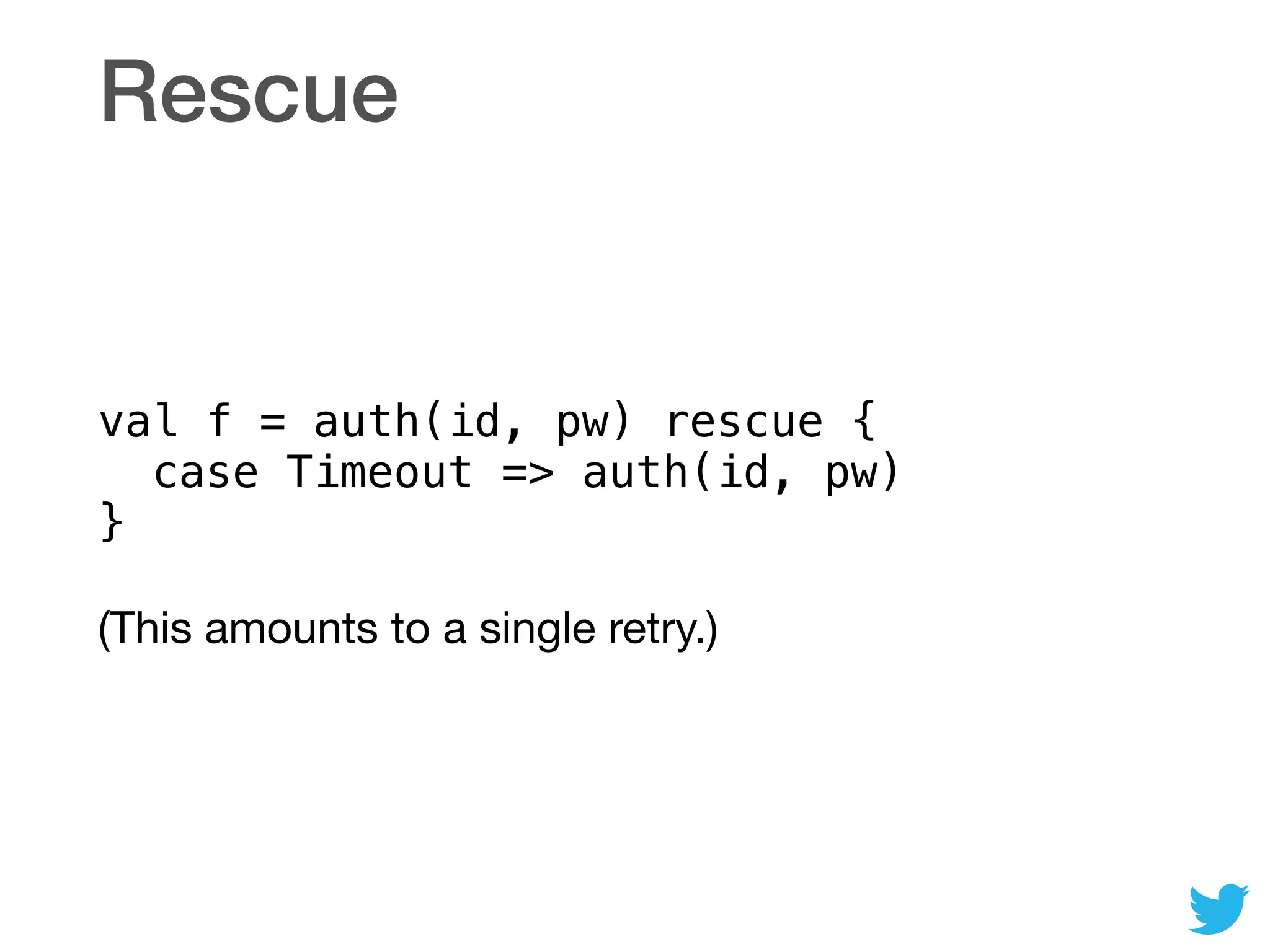

: Future[Seq[T]]
Waits for all futures to succeed, returning the
sequence of returned values.
The returned future fails should any constituent future
fail.](https://image.slidesharecdn.com/untitled-150112070044-conversion-gate01/75/Functional-Systems-Twitter-35-2048.jpg)
![Segmented search
def querySegment(id: Int, query: String)
: Future[Result]
def search(query: String)
: Future[Set[Result]] = {
val queries: Seq[Future[Result]] =
for (id <- 0 until NumSegments) yield {
querySegment(id, query)
}
Future.collect(queries) flatMap {
results: Seq[Set[Result]] =>
Future.value(results.flatten.toSet)
}
}](https://image.slidesharecdn.com/untitled-150112070044-conversion-gate01/75/Functional-Systems-Twitter-36-2048.jpg)
![Segmented search
def querySegment(id: Int, query: String)
: Future[Result]
def search(query: String)
: Future[Set[Result]] = {
val queries: Seq[Future[Result]] =
for (id <- 0 until NumSegments) yield {
querySegment(id, query)
}
Future.collect(queries) flatMap {
results: Seq[Set[Result]] =>
Future.value(results.flatten.toSet)
}
}
search
querySegment
rpc
querySegment
rpc
querySegment
rpc
querySegment
…
rpc…](https://image.slidesharecdn.com/untitled-150112070044-conversion-gate01/75/Functional-Systems-Twitter-37-2048.jpg)
![Services
A service is a kind of asynchronous function.
trait Service[Req, Rep]
extends (Req => Future[Rep])
val http: Service[HttpReq, HttpRep]
val redis: Service[RedisCmd, RedisRep]
val thrift: Service[TFrame, TFrame]](https://image.slidesharecdn.com/untitled-150112070044-conversion-gate01/75/Functional-Systems-Twitter-38-2048.jpg)
![Services are symmetric
// Client:
val http = Http.newService(..)
// Server:
Http.serve(..,
new Service[HttpReq, HttpRep] {
def apply(..) = ..
}
)
// A proxy:
Http.serve(.., Http.newService(..))](https://image.slidesharecdn.com/untitled-150112070044-conversion-gate01/75/Functional-Systems-Twitter-39-2048.jpg)
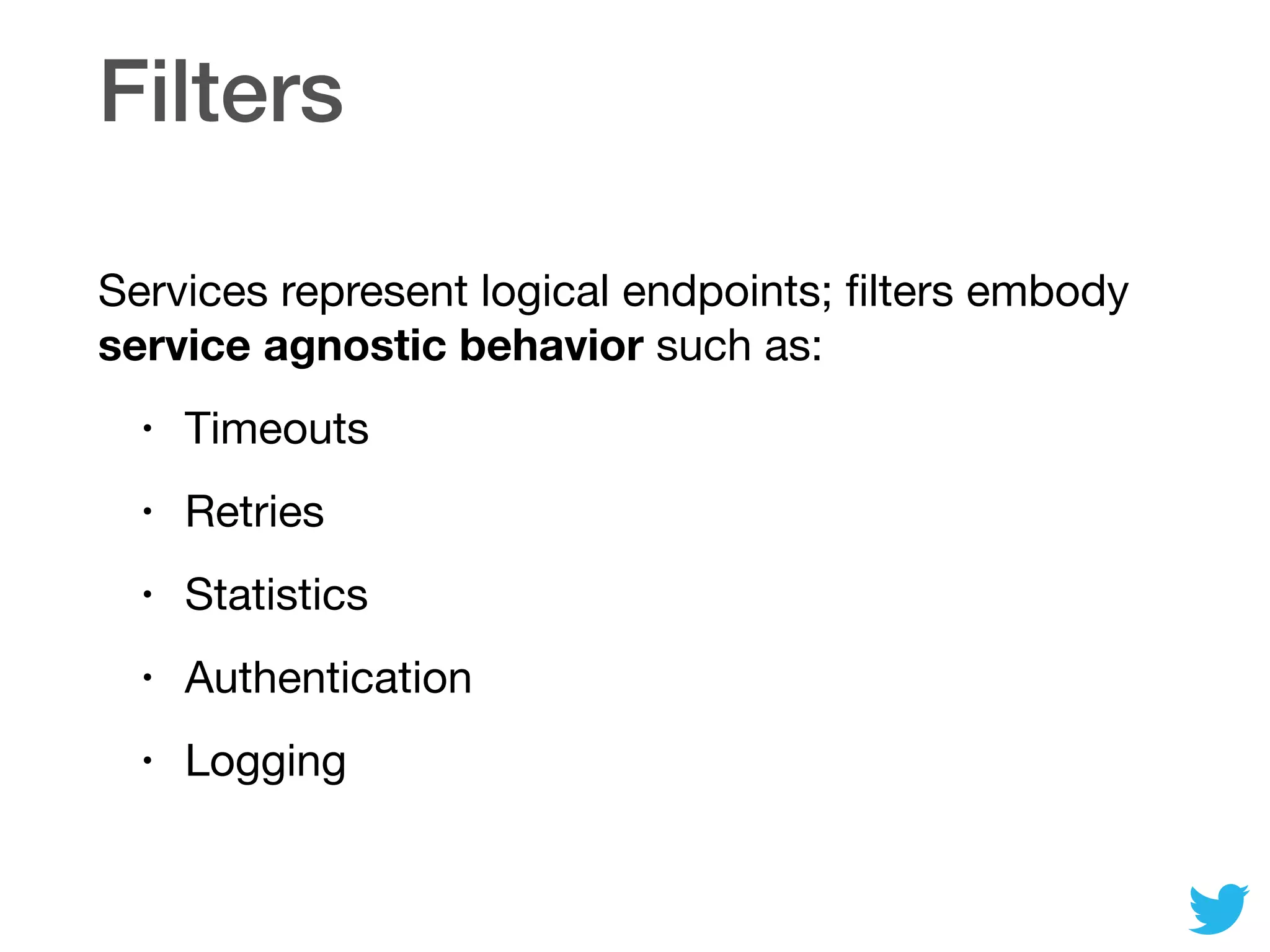
![trait Filter[ReqIn, ReqOut, RepIn, RepOut]
extends
((ReqIn, Service[ReqOut, RepIn]) => Future[RepOut])
ReqIn ReqOut RepIn RepOut
Filter[ReqIn, RepOut, ReqOut, RepIn]
Service[ReqOut, RepIn]](https://image.slidesharecdn.com/untitled-150112070044-conversion-gate01/75/Functional-Systems-Twitter-41-2048.jpg)

extends Filter[Req, Rep, Req, Rep] {
def apply(req: Req, svc: Service[Req, Rep]) =
svc(req).within(to)
}](https://image.slidesharecdn.com/untitled-150112070044-conversion-gate01/75/Functional-Systems-Twitter-42-2048.jpg)
![Example: authentication
class AuthFilter extends
Filter[HttpReq, AuthHttpReq, HttpReq, HttpRep]
{
def apply(
req: HttpReq,
svc: Service[AuthHttpReq, HttpRep]) =
auth(req) match {
case Ok(authreq) => svc(authreq)
case Failed(exc) => Future.exception(exc)
}
}](https://image.slidesharecdn.com/untitled-150112070044-conversion-gate01/75/Functional-Systems-Twitter-43-2048.jpg)
![Combining filters and services
val timeout = new TimeoutFilter(1.second)
val auth = new AuthFilter
val authAndTimeout = auth andThen timeout
val service: Service[..] = ..
val authAndTimeoutService =
authAndTimeout andThen service](https://image.slidesharecdn.com/untitled-150112070044-conversion-gate01/75/Functional-Systems-Twitter-44-2048.jpg)
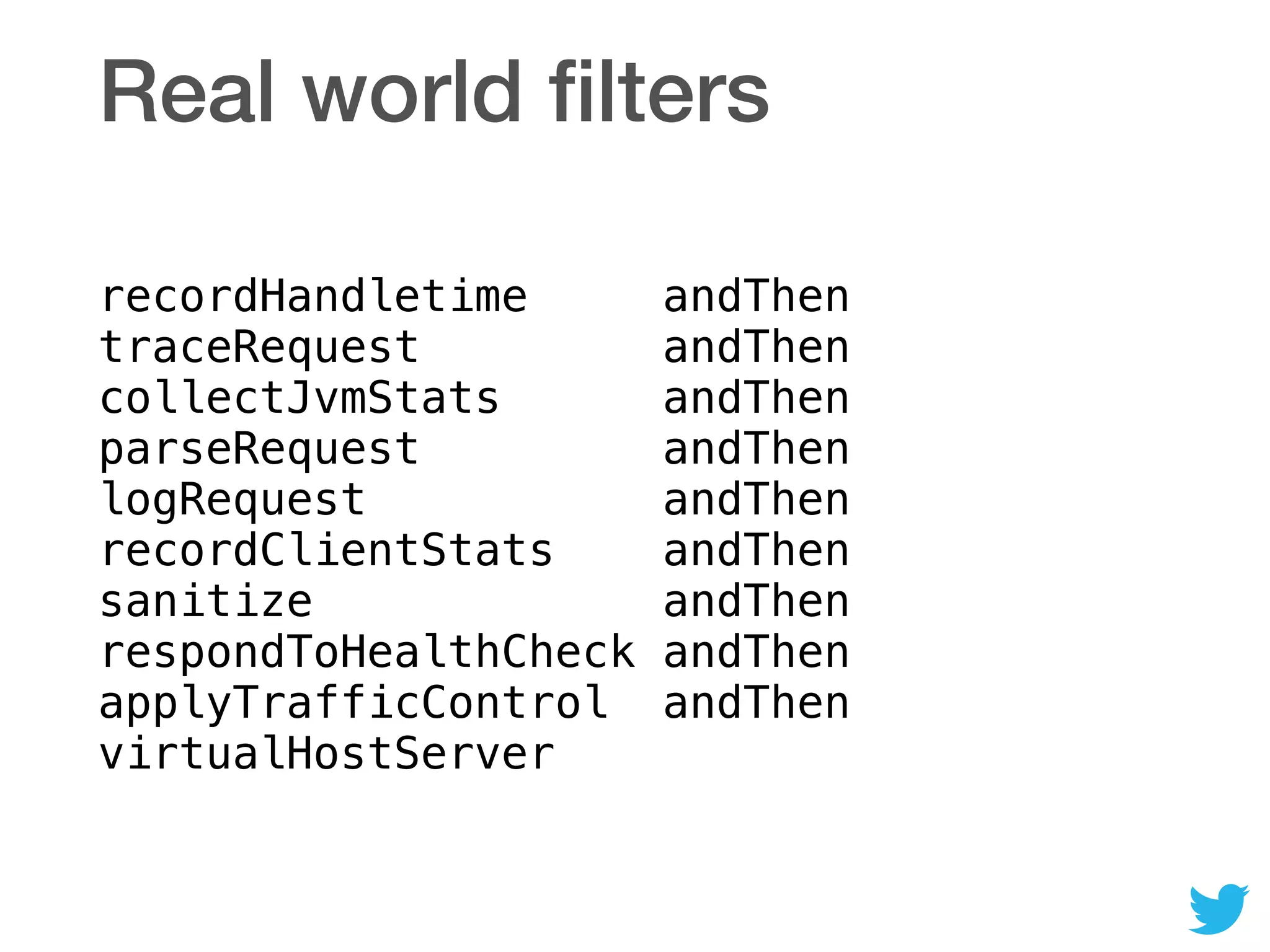
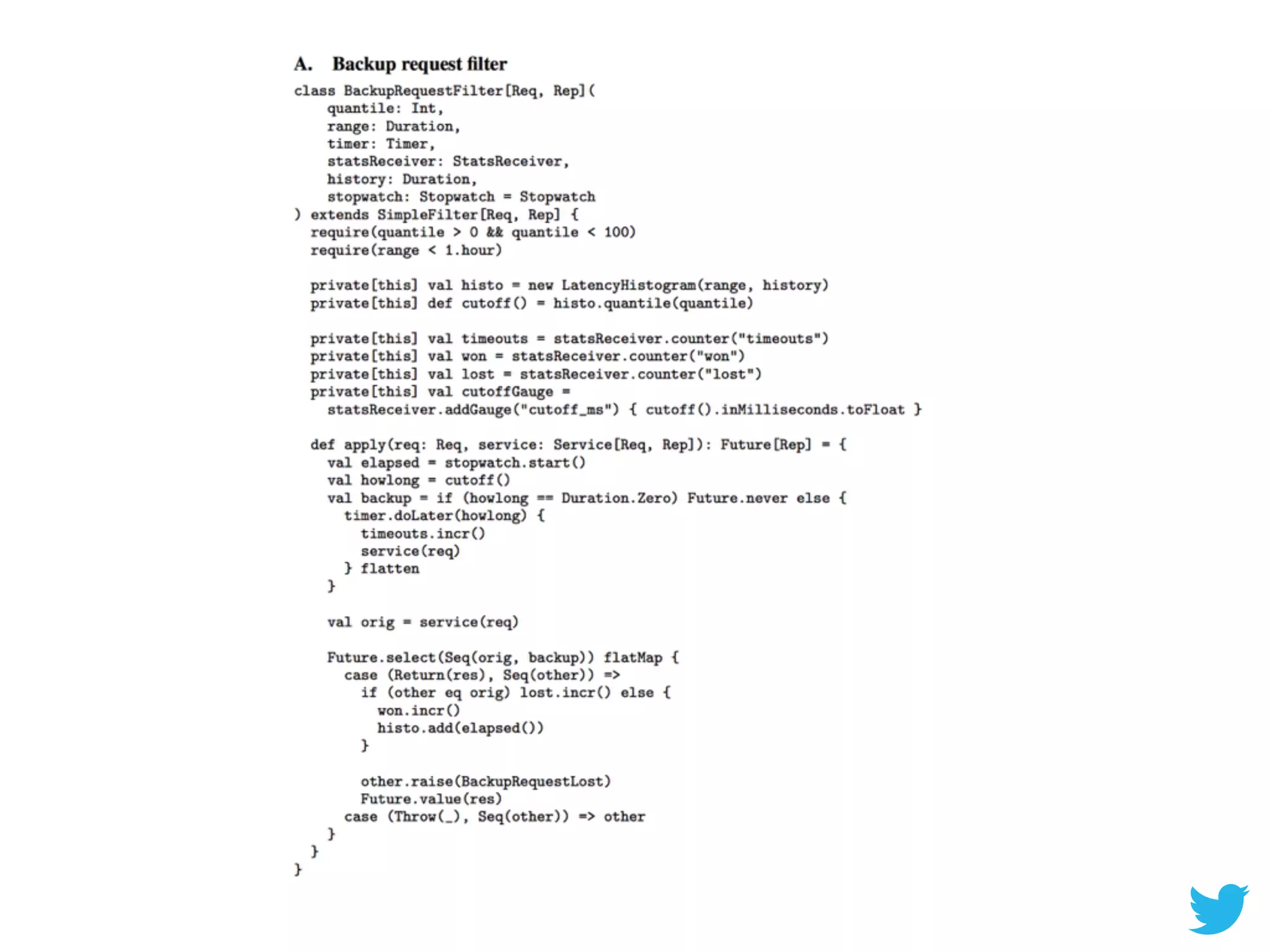
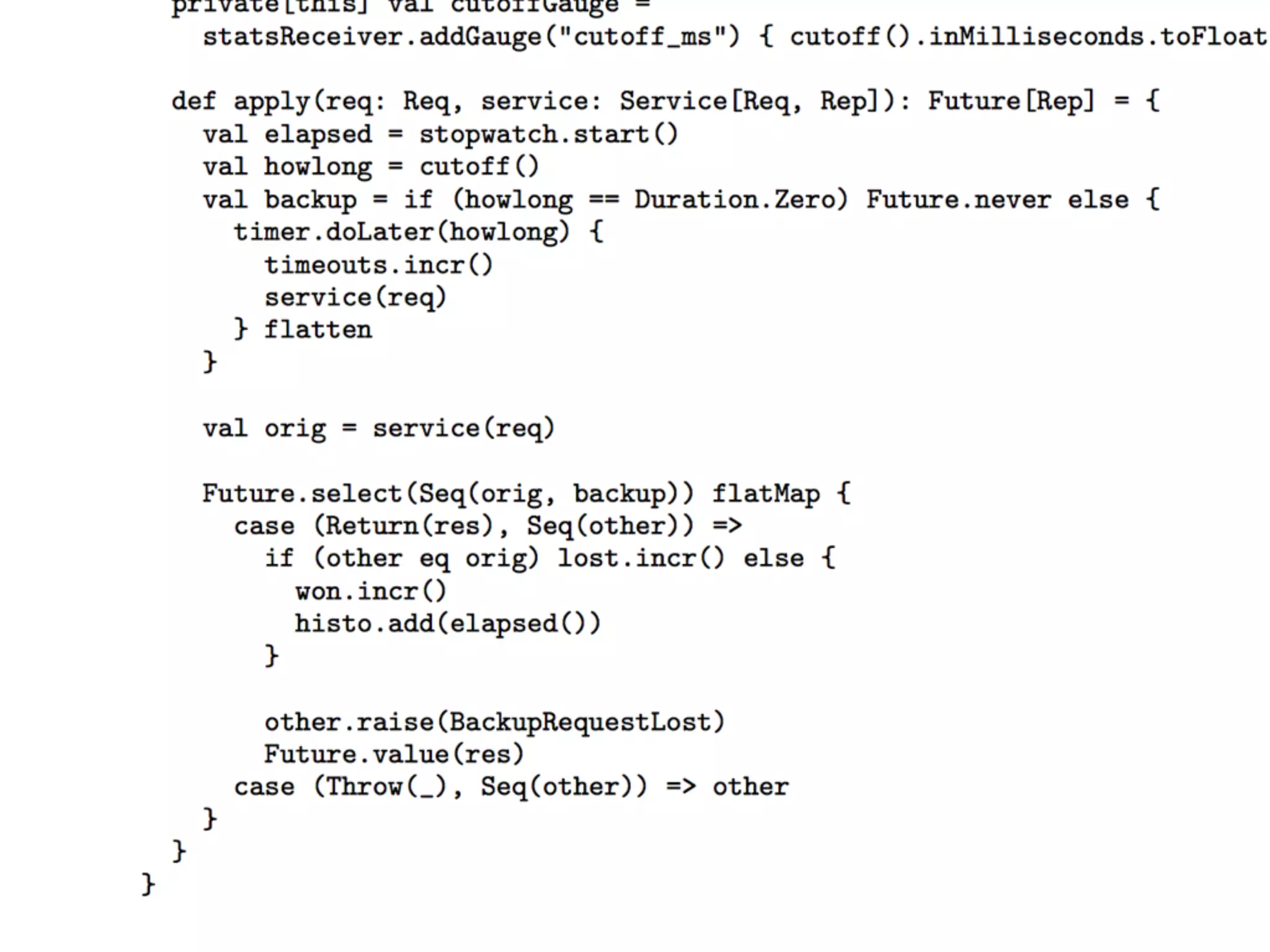
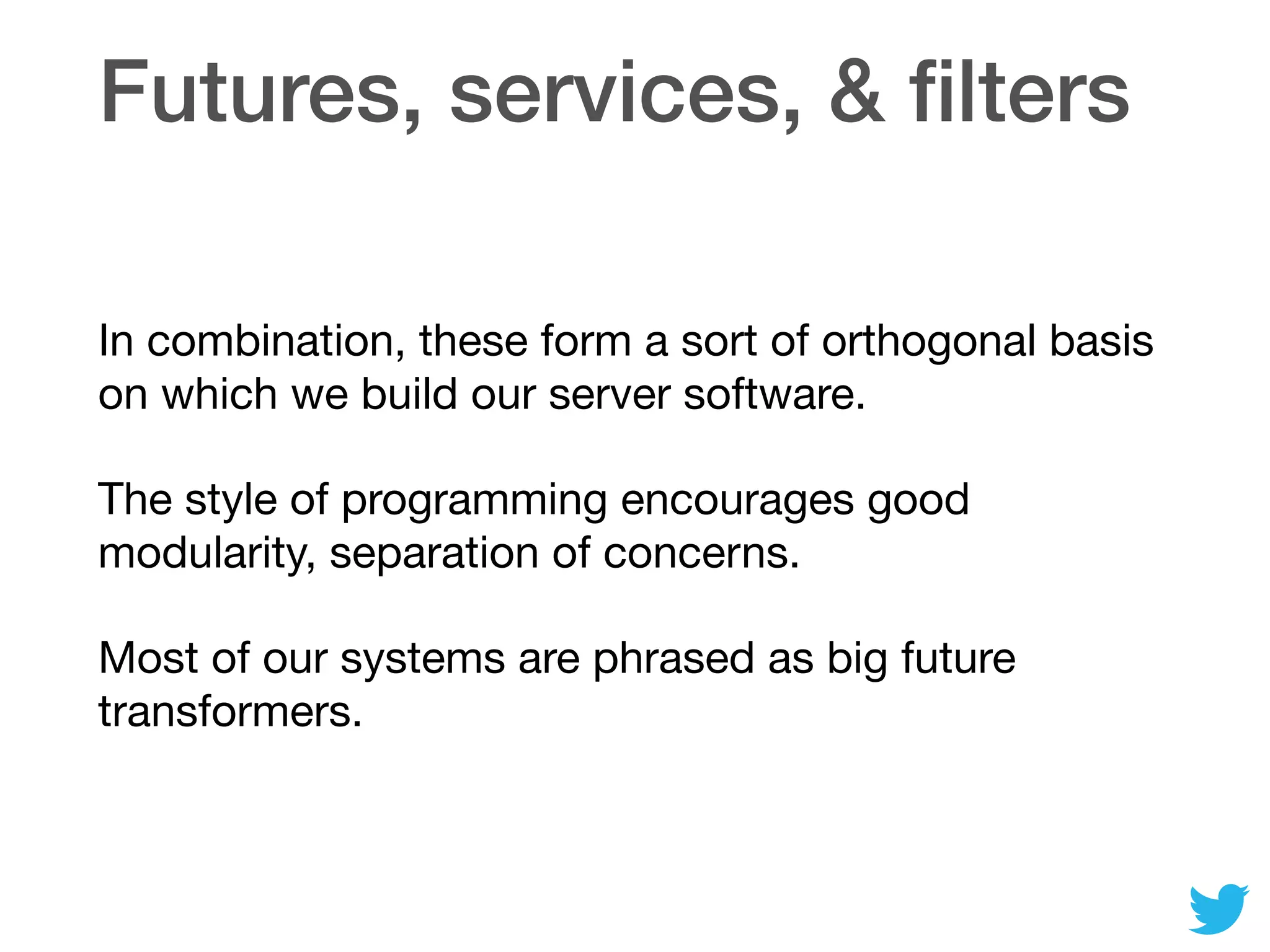
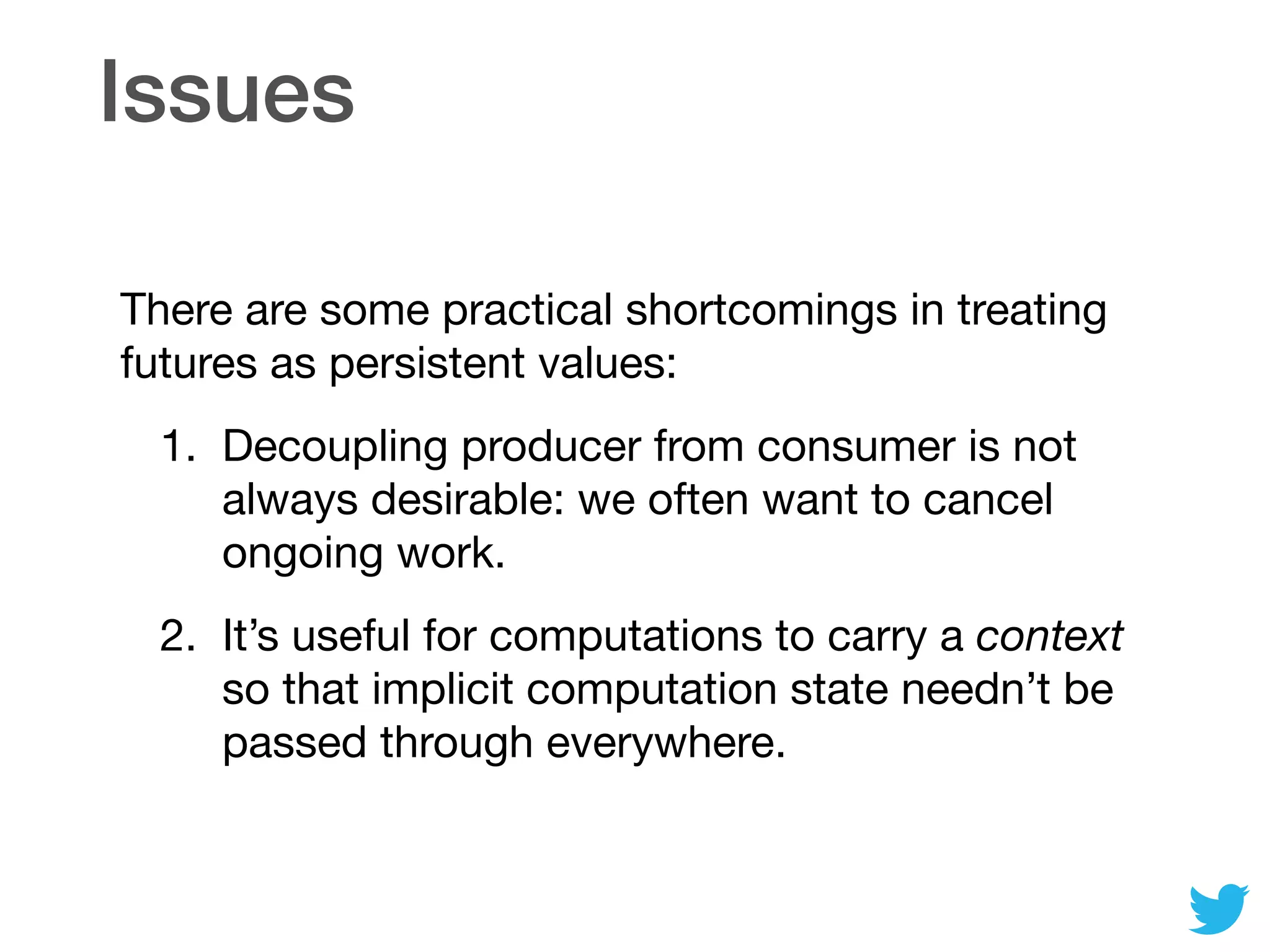
![Interrupts
val p = new Promise[Int]
p.setInterruptHandler {
case Cancelled =>
if (p.updateIfEmpty(Throw(..)))
cancelUnderlyingOp()
}
val f = p flatMap …
f.raise(Cancelled)](https://image.slidesharecdn.com/untitled-150112070044-conversion-gate01/75/Functional-Systems-Twitter-50-2048.jpg)
![Locals
// Locals are equivalent to
// thread-locals, but with arbitrary
// delimitation.
val f, g: Future[Int]
val l = new Local[Int]
l() = 123
f flatMap { i =>
l() += i
g map { j =>
l() + j
}
}](https://image.slidesharecdn.com/untitled-150112070044-conversion-gate01/75/Functional-Systems-Twitter-51-2048.jpg)

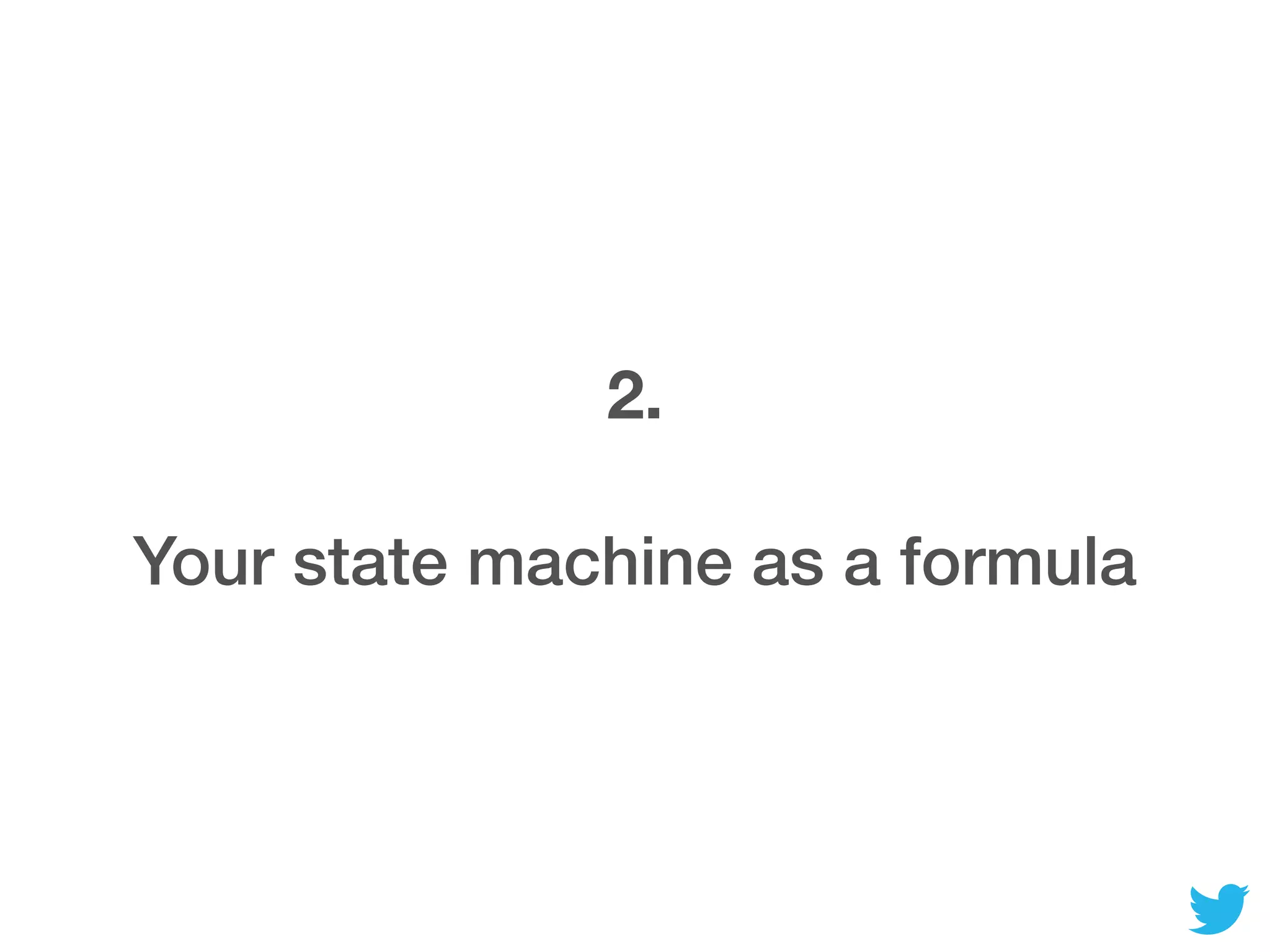
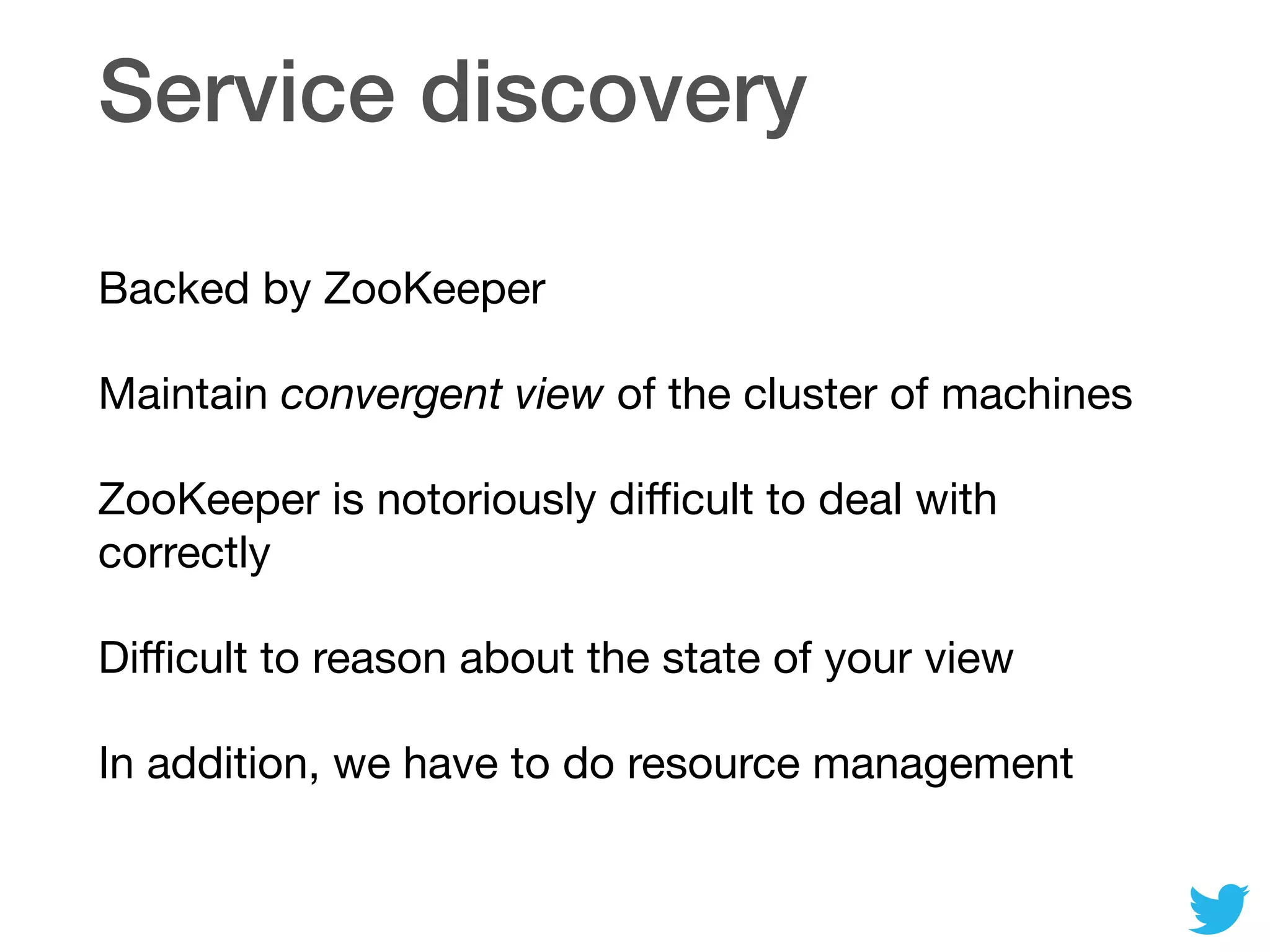
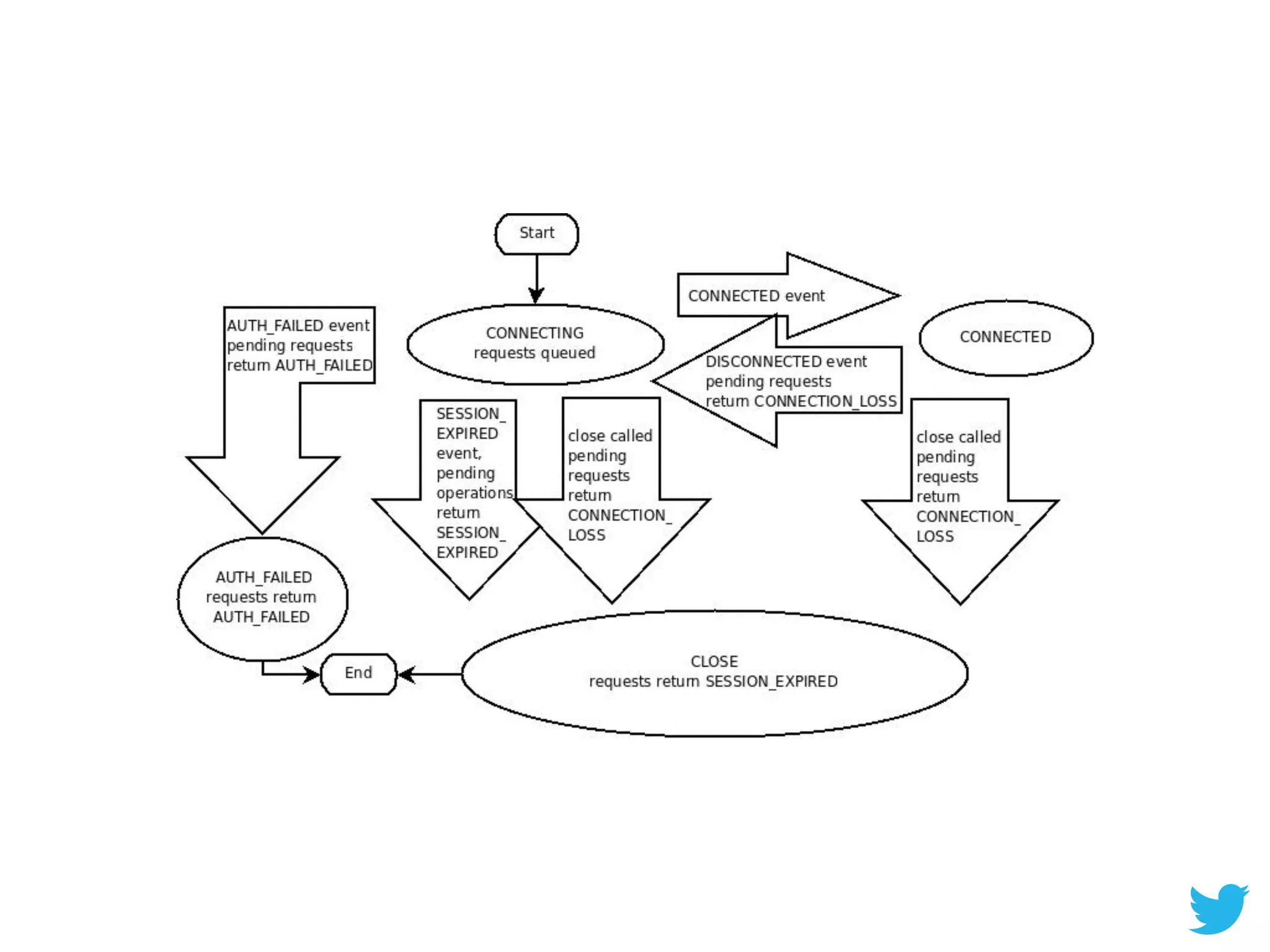
![com.twitter.util.Var
trait Var[+T] {
def flatMap[U](f: T => Var[U])
: Var[U]
def changes: Event[T]
…
}
trait Event[+T] {
def register(s: Witness[T]): Closable
…
}](https://image.slidesharecdn.com/untitled-150112070044-conversion-gate01/75/Functional-Systems-Twitter-56-2048.jpg)

val y = Var[Int](1)
val z: Var[Int] = for {
x0 <- x
y0 <- y
} yield x0 + y0
// z() == 3
x() = 100 // z() == 101
y() = 100 // z() == 200](https://image.slidesharecdn.com/untitled-150112070044-conversion-gate01/75/Functional-Systems-Twitter-57-2048.jpg)
![com.twitter.util.Activity
sealed trait State[+T]
case class Ok[T](t: T) extends State[T]
object Pending extends State[Nothing]
case class Failed(exc: Throwable)
extends State[Nothing]
case class Activity[+T](
run: Var[Activity.State[T]]) {
def flatMap[U](f: T => Activity[U])
: Activity[U] = …
…
}](https://image.slidesharecdn.com/untitled-150112070044-conversion-gate01/75/Functional-Systems-Twitter-58-2048.jpg)
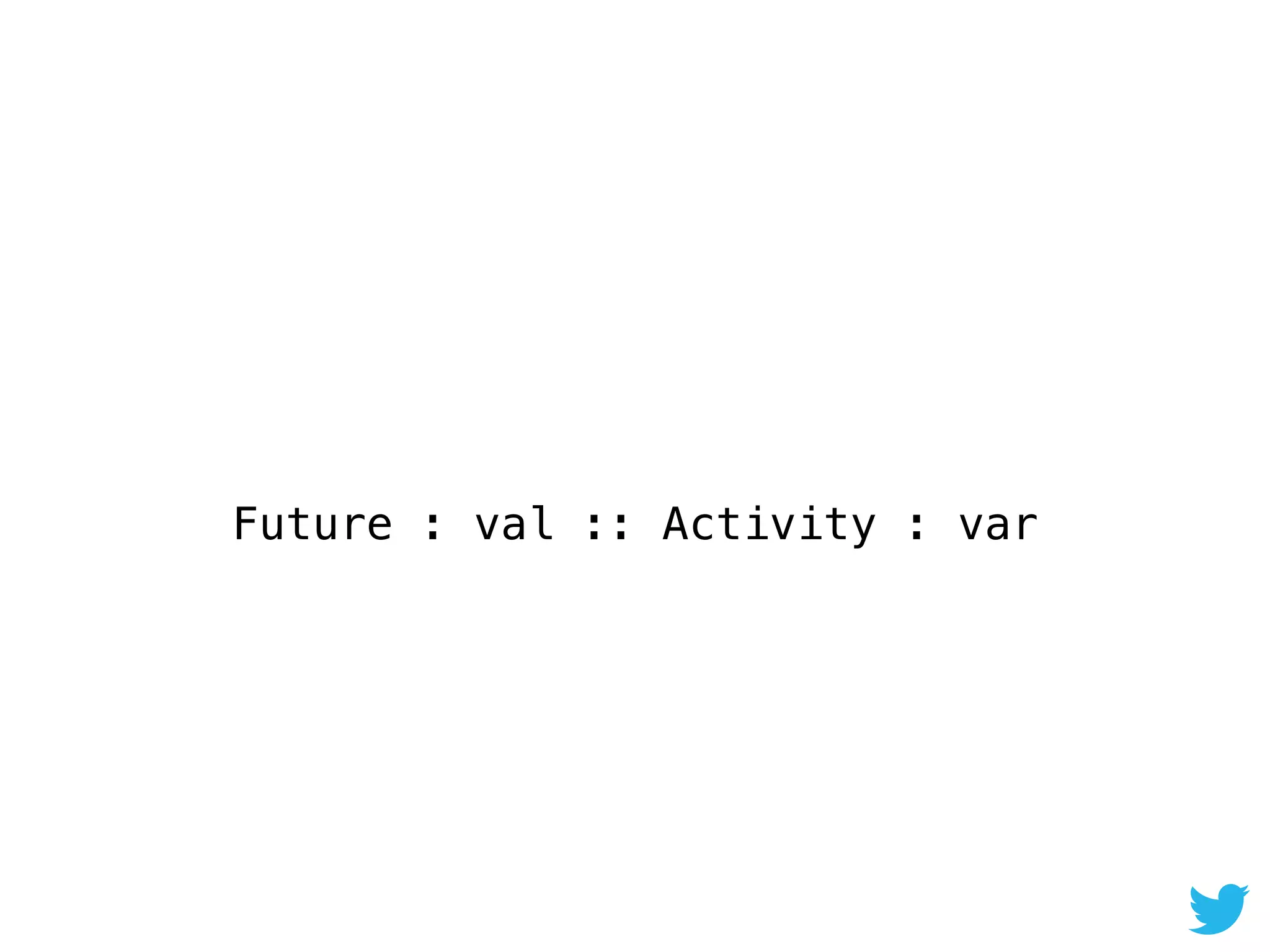
![A simple wrapper
// Turn ZooKeeper operations into
// activities.
case class Zk(underlying: ZooKeeper) {
def globOf(pat: String)
: Activity[Seq[String]] = …
def immutableDataOf(path: String)
: Activity[Option[Buf]] = …
def collectImmutableDataOf(paths: Seq[String])
: Activity[Seq[(String, Option[Buf])]] = {
def get(path: String)
: Activity[(String, Option[Buf])] =
immutableDataOf(path).map(path -> _)
Activity.collect(paths map get)
}
}](https://image.slidesharecdn.com/untitled-150112070044-conversion-gate01/75/Functional-Systems-Twitter-60-2048.jpg)
![Implementing serversets
case class Serverset(zk: Zk) {
def dataOf(pat: String)
: Activity[Seq[(String, Option[Buf])]] =
zk.globOf(pat).flatMap(
zk.collectImmutableDataOf)
def parse(Seq[(String, Option[Buf])])
: Set[SocketAddress] = ..
def entriesOf(pat: String)
: Activity[Set[SocketAddress]] =
dataOf(pat).map(parse)
}](https://image.slidesharecdn.com/untitled-150112070044-conversion-gate01/75/Functional-Systems-Twitter-61-2048.jpg)
![Broken ZK clients
class VarServerSet(v: Var[ServerSet]) {
def entriesOf(path: String)
: Activity[Set[Entry]] = Activity(
v.flatMap(ss =>
ss.entriesOf(path.run))
}](https://image.slidesharecdn.com/untitled-150112070044-conversion-gate01/75/Functional-Systems-Twitter-62-2048.jpg)
![Retrying ZK instance
object Zk {
// Constructor for dynamic ZK
// instance.
def retrying(backoff: Duration)
: Var[Zk]
…
}](https://image.slidesharecdn.com/untitled-150112070044-conversion-gate01/75/Functional-Systems-Twitter-63-2048.jpg)
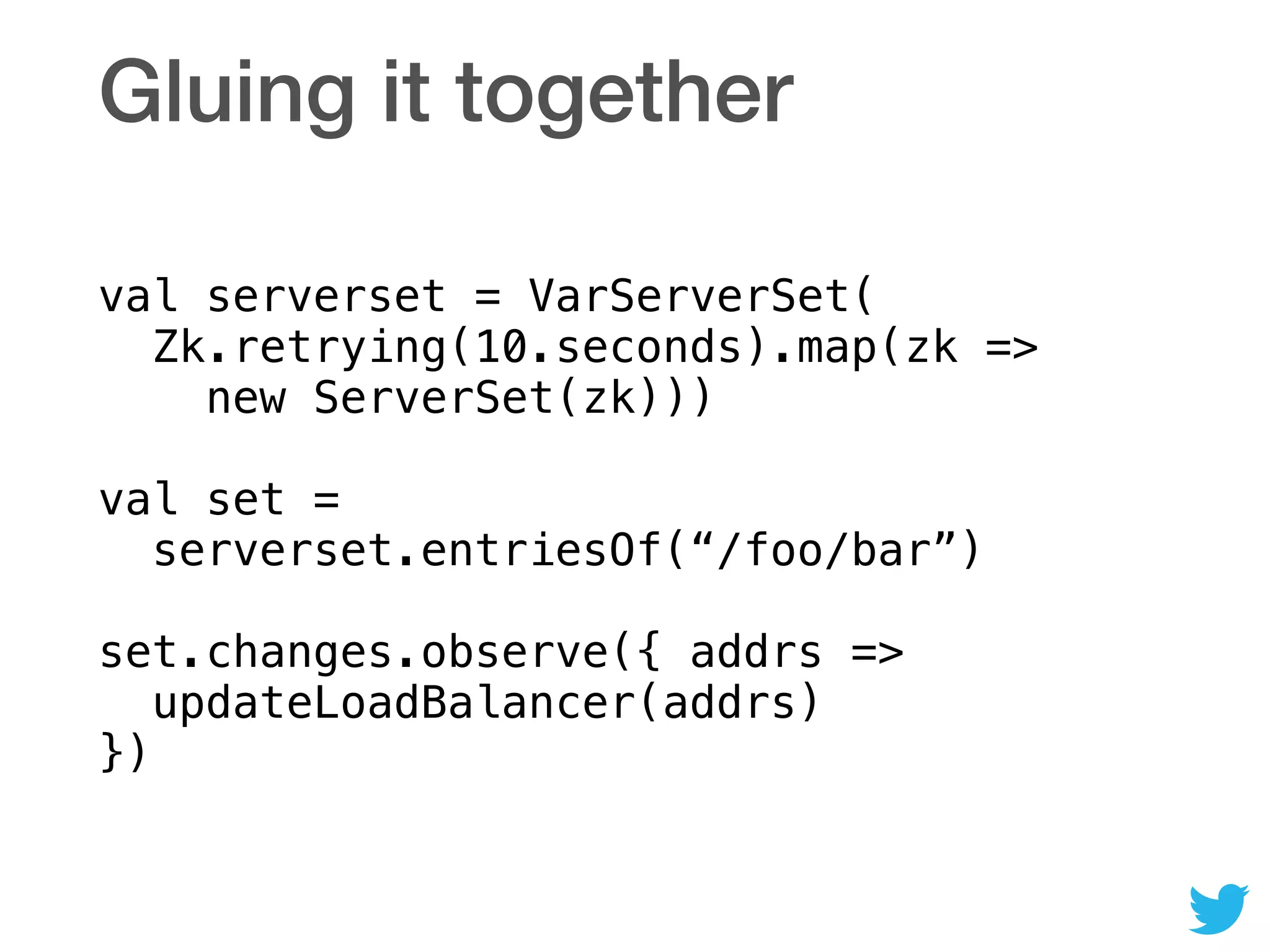
![Resource management
trait Event[+T] {
def register(s: Witness[T]): Closable
…
}
trait Closable {
def close(deadline: Time)
: Future[Unit]
…
}](https://image.slidesharecdn.com/untitled-150112070044-conversion-gate01/75/Functional-Systems-Twitter-65-2048.jpg)
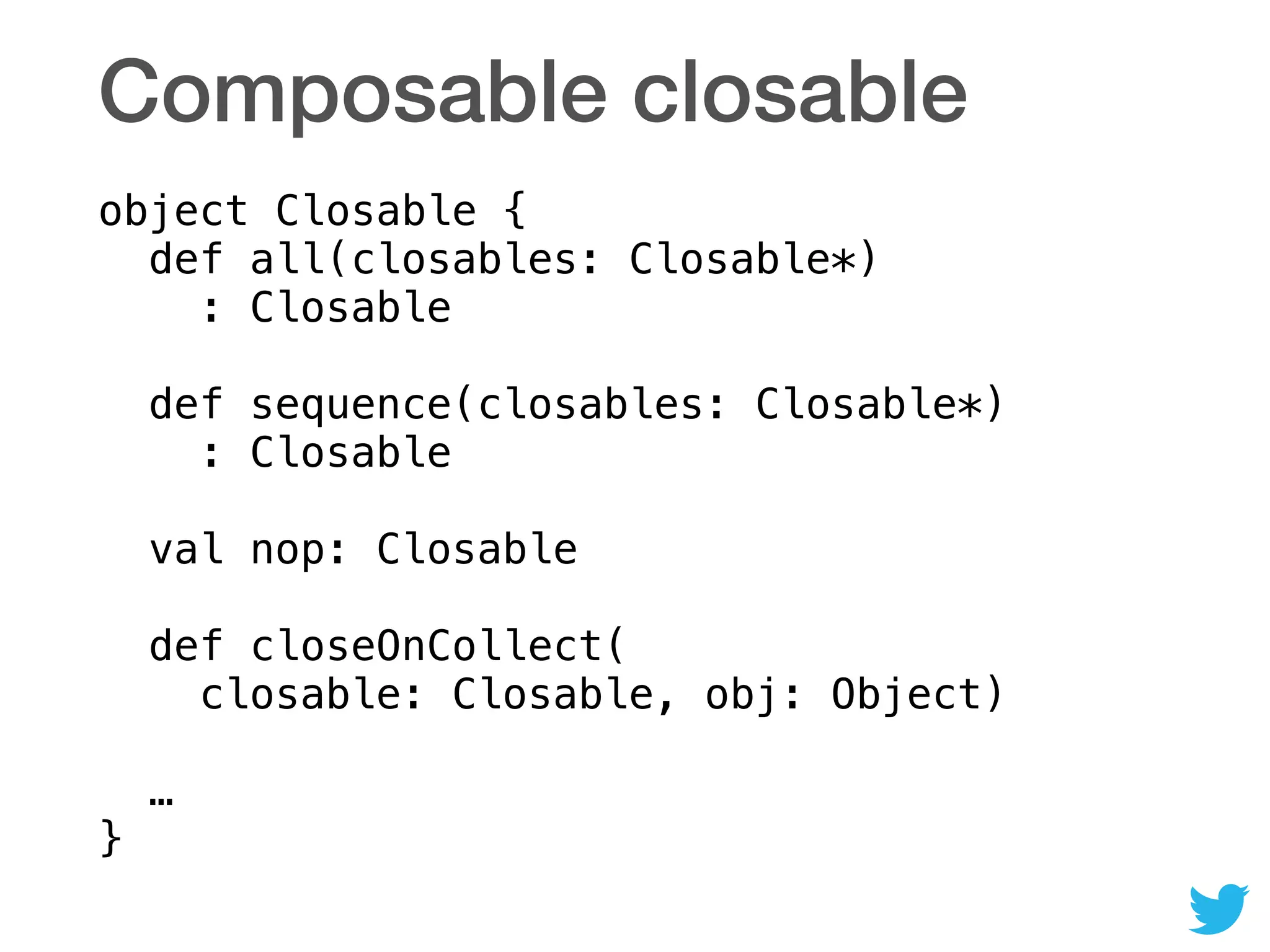
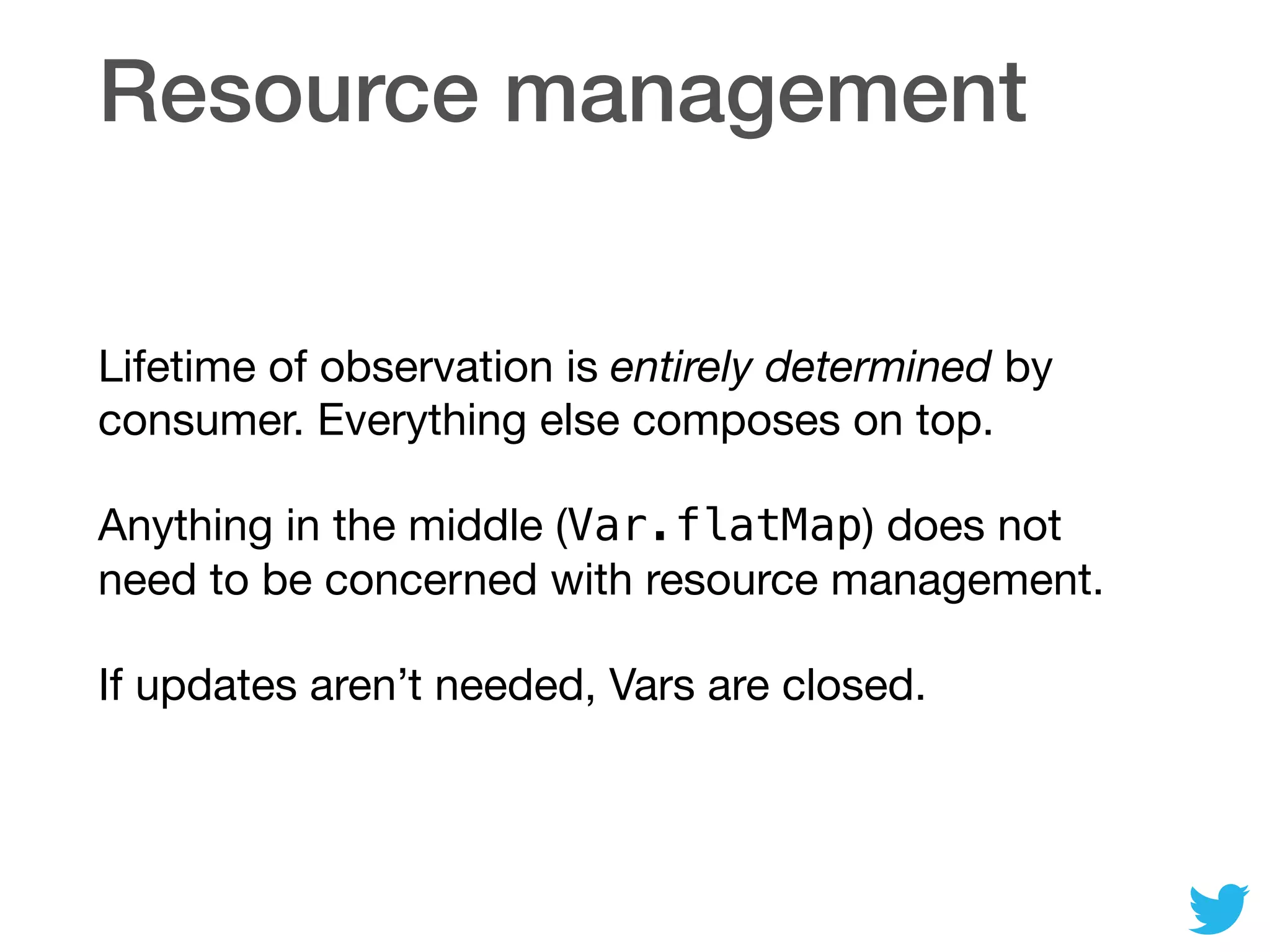
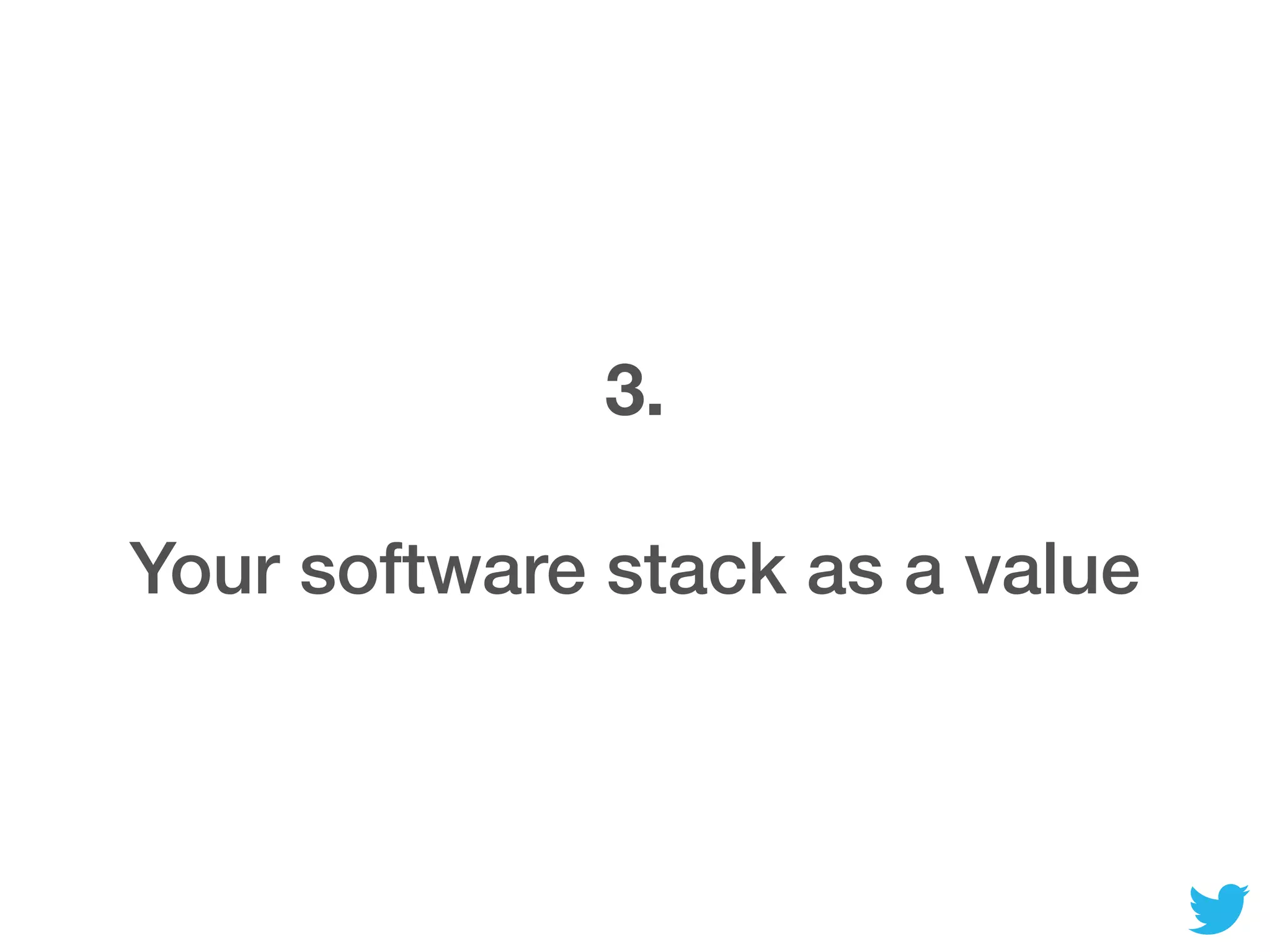
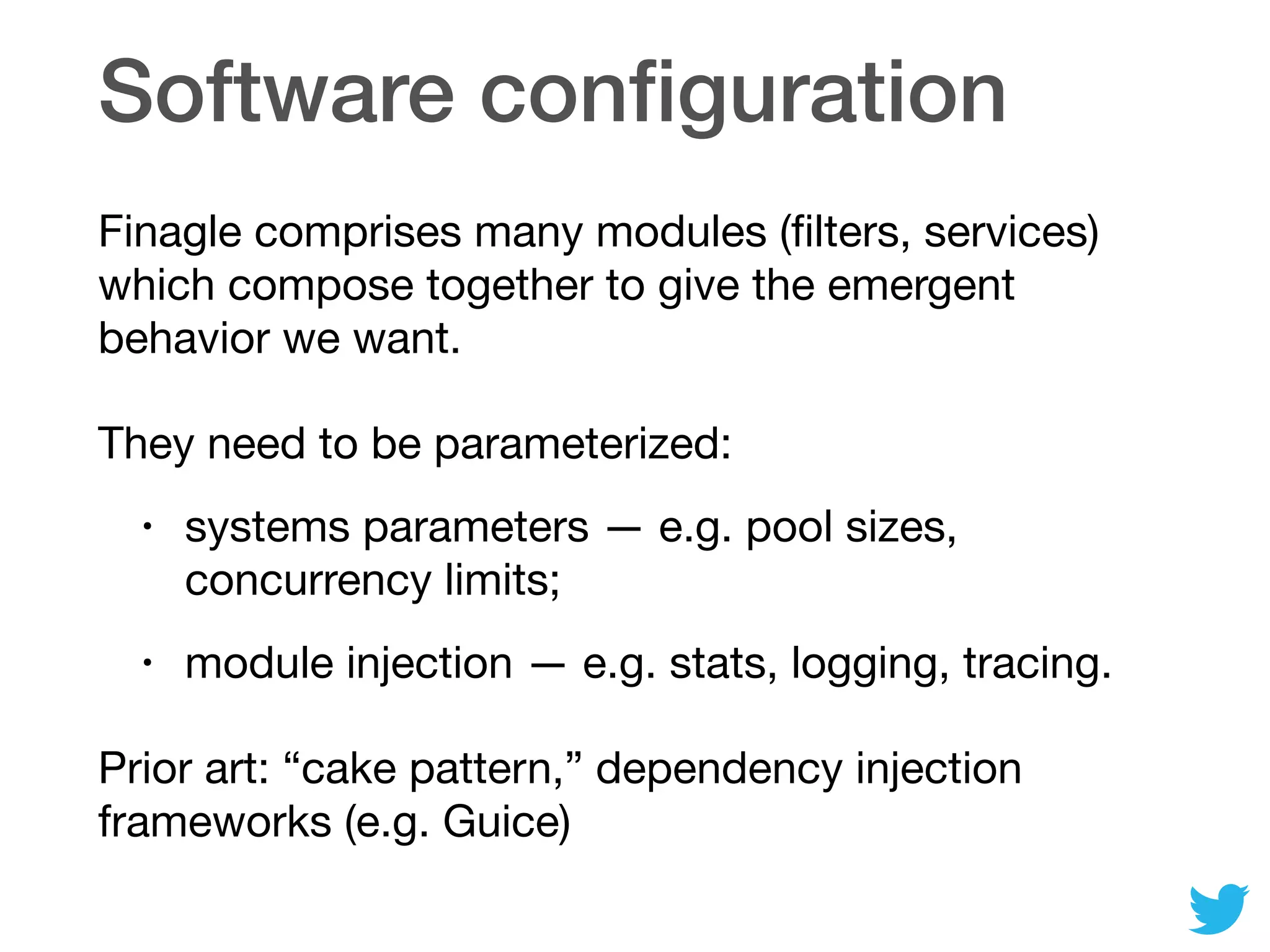
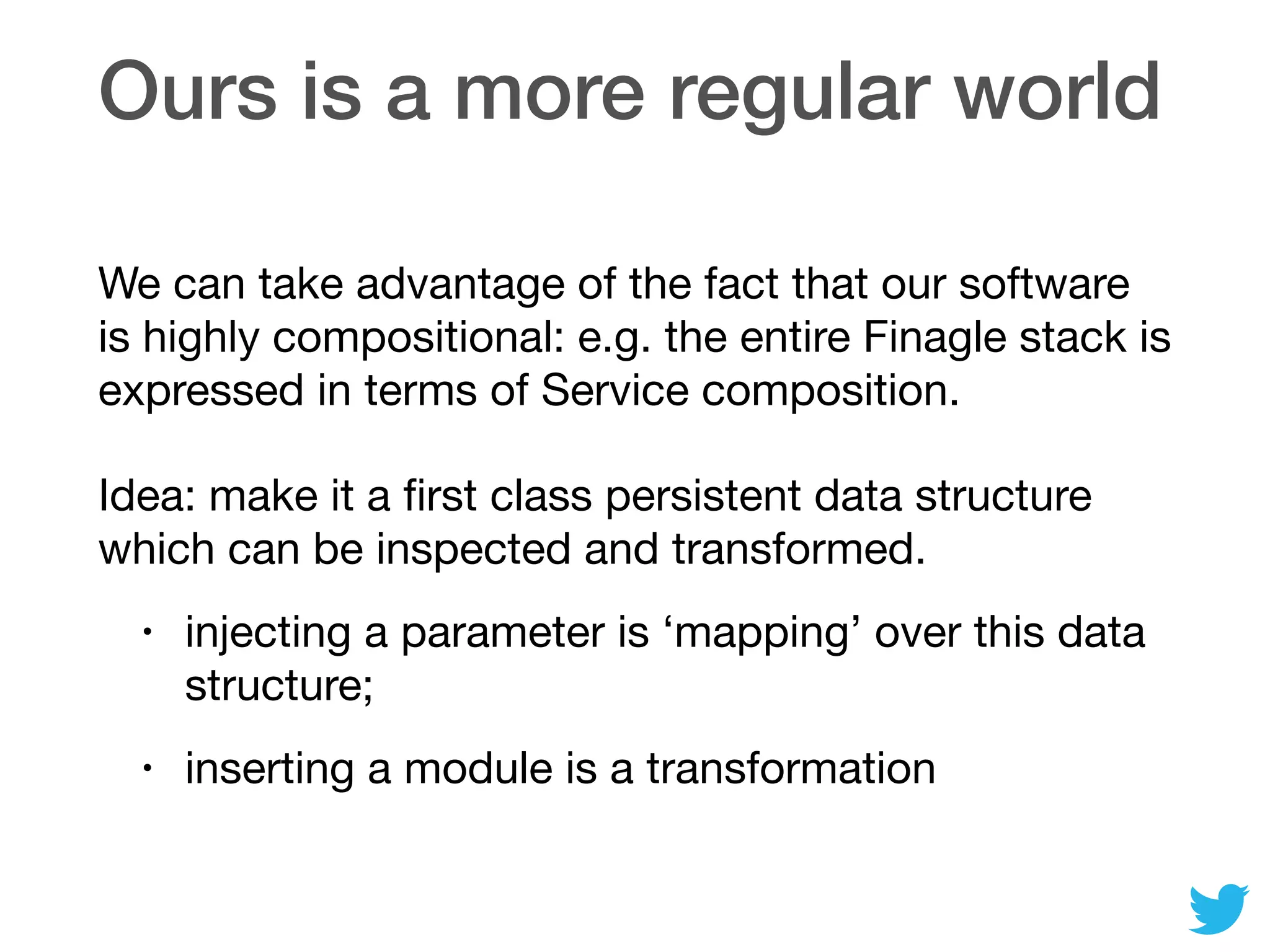
![com.twitter.finagle.Stack
trait Stack[T] {
def transform(
fn: Stack[T] => Stack[T]): Stack[T]
def ++(right: Stack[T]): Stack[T]
def +:(stk: Stackable[T]): Stack[T]
def make(params: Params): T
}](https://image.slidesharecdn.com/untitled-150112070044-conversion-gate01/75/Functional-Systems-Twitter-71-2048.jpg)
 => Stack[T],
next: Stack[T]
) extends Stack[T] {
def make(params: Params) =
mk(params, next).make(params)
}
case class Leaf[T](t: T)
extends Stack[T] {
def make(params: Params) = t
}](https://image.slidesharecdn.com/untitled-150112070044-conversion-gate01/75/Functional-Systems-Twitter-72-2048.jpg)
![Parameters
// A typeclass for parameter types
trait Param[P] {
def default: P
}
trait Params {
def apply[P: Param]: P
def contains[P: Param]: Boolean
def +[P: Param](p: P): Params
}](https://image.slidesharecdn.com/untitled-150112070044-conversion-gate01/75/Functional-Systems-Twitter-73-2048.jpg)
![Parameter definition
case class Poolsize(min: Int, max: Int)
implicit object Poolsize
extends Stack.Param[Poolsize] {
val default =
Poolsize(0, 100)
}](https://image.slidesharecdn.com/untitled-150112070044-conversion-gate01/75/Functional-Systems-Twitter-74-2048.jpg)
![Parameter use
val params: Params
val Poolsize(min, max) = params[Poolsize]
…
new Pool(min, max)](https://image.slidesharecdn.com/untitled-150112070044-conversion-gate01/75/Functional-Systems-Twitter-75-2048.jpg)
![Modules
object FailFast {
def module[Req, Rep] =
new Stack.Module2[Stats, Timer, ServiceFactory[Req, Rep]] {
def make(
stats: Stats,
timer: Timer,
next: ServiceFactory[Req, Rep]) =
new FailFastFactory(
next, stats.scope("failfast"), timer)
}](https://image.slidesharecdn.com/untitled-150112070044-conversion-gate01/75/Functional-Systems-Twitter-76-2048.jpg)
![Building
val stk = new StackBuilder[ServiceFactory[Req, Rep]]
(nilStack[Req, Rep])
stk.push(ExpiringService.module)
stk.push(FailFastFactory.module)
stk.push(DefaultPool.module)
stk.push(TimeoutFilter.module)
stk.push(FailureAccrualFactory.module)
stk.push(StatsServiceFactory.module)
stk.push(StatsFilter.module)
stk.push(ClientDestTracingFilter.module)
stk.push(MonitorFilter.module)
stk.push(ExceptionSourceFilter.module)
val stack: Stack[ServiceFactory[Req, Rep]] =
stk.result](https://image.slidesharecdn.com/untitled-150112070044-conversion-gate01/75/Functional-Systems-Twitter-77-2048.jpg)
![Using
val params = Params.empty +
Stats(statsReceiver) +
Poolsize(10, 50) +
…
val factory: ServiceFactory[..] =
stack.make(params)](https://image.slidesharecdn.com/untitled-150112070044-conversion-gate01/75/Functional-Systems-Twitter-78-2048.jpg)
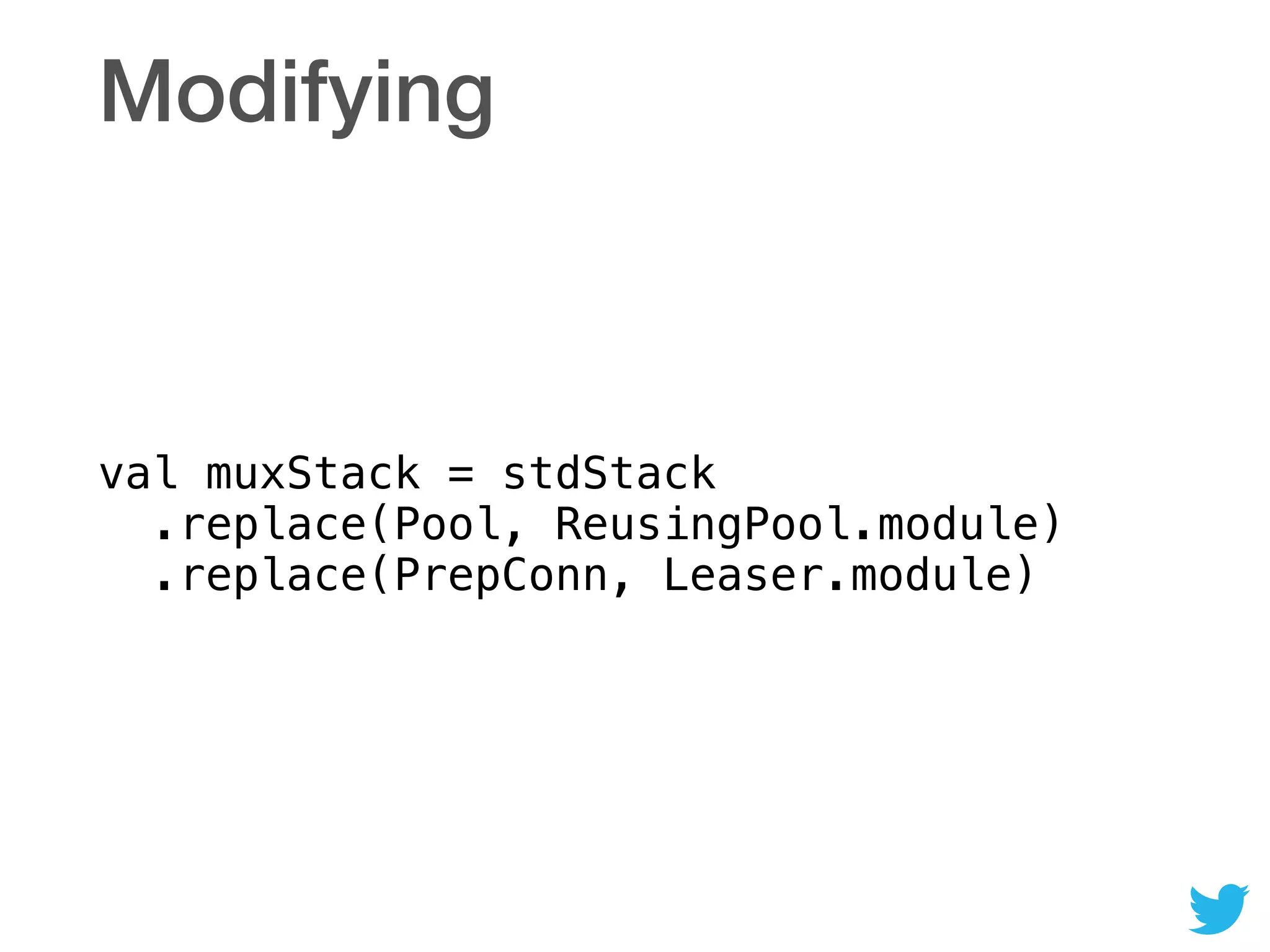
![Inspection
scala> println(StackClient.newStack[Int, Int])
Node(role = prepfactory, description = PrepFactory)
Node(role = tracer,
description = Handle span lifecycle events to report tracing from protocols)
Node(role = servicecreationstats,
description = Track statistics on service creation failures and .. latency)
Node(role = servicetimeout,
description = Time out service acquisition after a given period)
Node(role = requestdraining, description = RequestDraining)
Node(role = loadbalancer, description = Balance requests across multiple
endpoints)
Node(role = exceptionsource, description = Source exceptions to the service name)
Node(role = monitoring, description = Act as last-resort exception handler)
Node(role = endpointtracing, description = Record remote address of server)
Node(role = requeststats, description = Report request statistics)
Node(role = factorystats, description = Report connection statistics)
Node(role = failureaccrual,
description = Backoff from hosts that we cannot successfully make requests to)
Node(role = requesttimeout, description = Apply a timeout to requests)
Node(role = pool, description = Control client connection pool)
Node(role = failfast,
description = Backoff exponentially on connection failure)
Node(role = expiration,
description = Expire a service after a certain amount of idle time)
Node(role = prepconn, description = PrepConn)
Leaf(role = endpoint, description = endpoint)](https://image.slidesharecdn.com/untitled-150112070044-conversion-gate01/75/Functional-Systems-Twitter-80-2048.jpg)
